

How Far Do Pro Golfers Hit Each Club? A 2022 Guide
Written by Graeme Hay | Last Updated: 12/03/2024
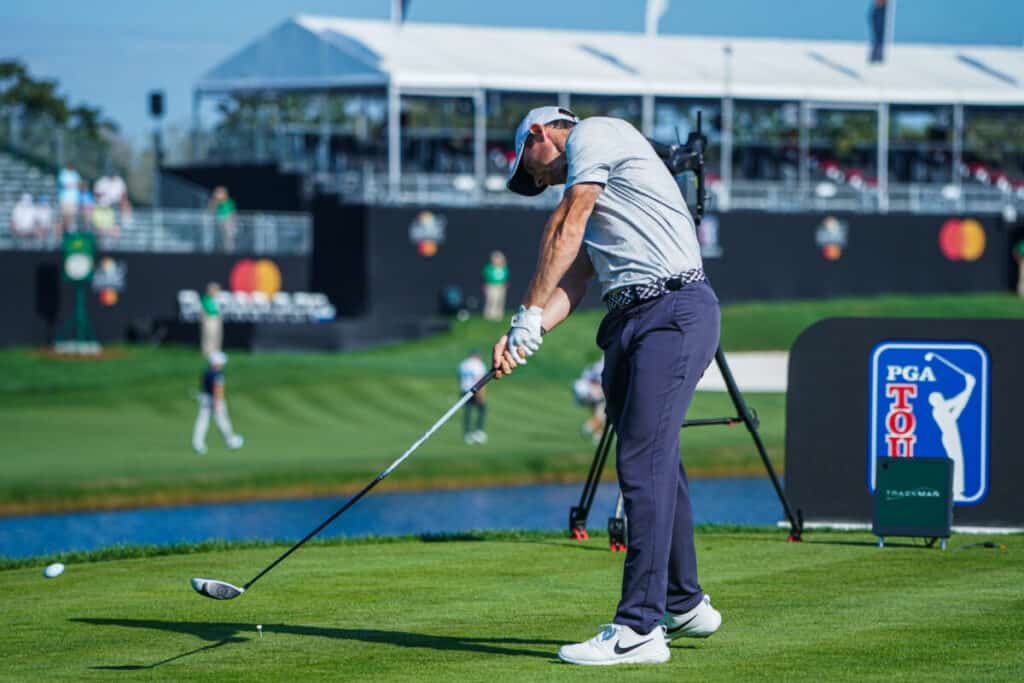
When you watch the PGA Tour or any major championship on TV it is hard not to notice how far pro golfers hit the ball.
Their drives seem to always go miles and I don’t know about you but I’m always checking myself to think whether I indeed heard the commentator correctly that they are actually hitting that high an iron for that 200+ yard approach shot.
So just to confirm what we are indeed up against we took a detailed look at just how far the top pros are hitting their clubs.
On average pros drive the ball a total of 296.6 yards (yds) according to official PGA Shotlink data. They hit a 3-wood an average carry distance of 249 yds, a 5-wood 235 yds and 3-hybrids 230 yds. 3-irons average 217 yds, 4-irons 208 yds, 5-irons 199 yds, 6-irons 188 yds, 7-irons 177 yds, 8-irons 164 yds and 9-irons 153 yds.
These high-level numbers of course don’t always tell the whole story as the pros like us are faced with an infinite variety of golf shots which don’t always mean they are hitting each club as far as they possibly can for every shot.
But if you take the averages over a season you are going to get more than a good idea of how far the pros are hitting each club.
What is fascinating also though as you dig more into the figures is the distance control options the best players in the world have with almost every club in their bag!

How Far Do Pros Hit Their Driver and Woods?
When it comes to talking about distance in golf the easiest and most obvious place to start is of course always with the longest club in the golf bag – the driver.
And as it is highly unlikely even the best pros in the world never want to hit their driver as far as they can so it is clearly the club we are going to get the best idea of the maximum distance they hit the ball.
So how far do pros drive?
PGA Tour players hit their driver a ‘total’ of 296.6 yards on average with a ‘carry’ distance of 284.3 yards according to official 2022 Shotlink data. The longest player hits it 320 yards on average and the longest recorded drive in 2022 is 460 yards. On the LPGA Tour the top pros hit their driver an average of 257.7 yards.
When it comes to how far the pros hit a 3 wood and the other longer clubs in the bag including their hybrids the distance analysis gets a bit more complicated because clearly the pros are starting to use these clubs for a wider variety type of shots than they do for their driver.
The pros, like the rest of us, will be hitting a driver as far as they can 99% of the time but when it comes to their 3-wood, 5-wood and hybrids they can be using those clubs off the tee and for approach shots and will not always be aiming for their maximum yardage with those clubs.
The best distance comparison we have for those clubs is therefore the ‘carry distance’. In other words the distance from where they hit the ball to the point of impact on the ground.
On average PGA Tour pros hit a 3-wood a ‘carry’ distance of 249 yards. By comparison a 5-wood carries 235 yards and hit a 3 hybrid, which measures from 19º to 21º, an average carry distance of 230 yards. On the LPGA Tour the top women pros carry a 3-wood 195 yards, a 5-wood 185 yards and a 7-wood 174 yards on average.
For those of you interested in how these averages compare to individual pros we have listed in the table below the average ‘stock’ carry yardages for a selection of the top pros when it comes to how far they hit their driver.
In the following table the list shows how far a selection of PGA and LPGA Tour pros hit their 3-wood, 5-wood and hybrid clubs.
[Note – If you are interested in what drivers and fairway woods the top 100 PGA Tour players are using check out the in-depth analysis we have done here .]
How Far Do Pros Hit Their Irons? Remember to Take Stock
Looking at how far pros hit their irons is a much easier task these days due to all the tracking technology that exists however it still does not make it an exact science.
And that is for the simple reason that pros will hit all manner of a variety of different shots with their irons, especially for their approach shots, and as such, they will hit the same iron a variety of different distances.
A look at Brooks Koepka’s yardage book below gives us a great insight into this and highlights how many types of shots pros can play with their irons.
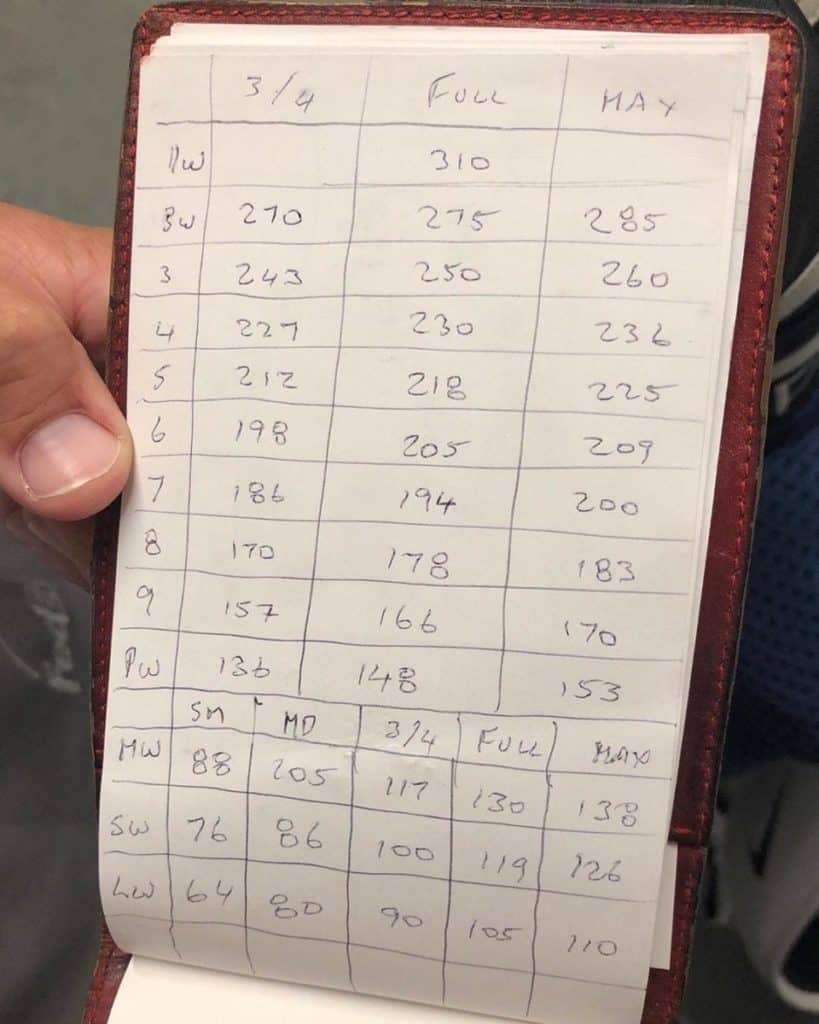
For example for a 170 yard shot into the green a quick glance at his iron yardages shows he could decide to play either a three-quarter 8-iron or try to hit a 9-iron as far as he can – his ‘max’ distance for that club.
When you account for factors such as wind, elevation, ground conditions and also the context in which the shot is being played Koepka, like all the pros, has a number of options for each iron shot which makes the question of how far he hits each iron a bit more complex than at first you may think.
However the pros have what is called a ‘stock’ yardage for their irons, which equates essentially to the average distance they will hit a full shot with each iron swinging normally.
When we compare these ‘stock yardages’ for irons between the pros we get a consistent view of yardage which we can accurately compare across the players.
On average PGA pros hit a 3-iron a ‘carry’ distance – the distance from strike to point of ground impact – of 217 yards. They hit 4-irons 208 yards and 5-irons 199 yards on average. For 6-irons the average is 188 yards, for 7-irons it is 177 yards and 8-irons, 9-irons and pitching wedges go 164, 153 and 141 yards respectively.
Different pros however clearly hit their irons different distances but in the table below we have listed the ‘stock yardages’ of some of the top pros, including Rory McIlroy, Dustin Johnson, Justin Thomas and Bryson DeChambeau, to let you see how they compare against the average.
And when it comes to how far Tiger Woods, arguably the greatest iron player of all time, hits his irons?
Tiger hits his 3-iron a ‘carry’ distance of 240 yards on average while his 4-iron goes 225 yards and 5-iron 210 yards. When it comes to his mid-irons he hits his 6-iron and 7-iron 195 and 180 yards. As for his short irons his 8-iron yardage is 165, he hits his 9-iron 150 yards and his pitching wedge 135 yards on average.
How Far Do Pros Hit Their Wedges
When it comes to looking at how far the pros hit their wedges the stock yardage they hit each club is again obviously only one of the multiple yardages they can hit the most versatile clubs in any player’s golf bag.
As we can again see from Brooks Koepka’s yardage book above he has 5 different yardages listed for each of his specialist wedges which highlights just how much distance control the best golfers in the world can exert with their wedges.
Another added complication when it comes to comparing the distances that the pros hit their wedges is the differing lofts each of them often carries for seemingly the same club.
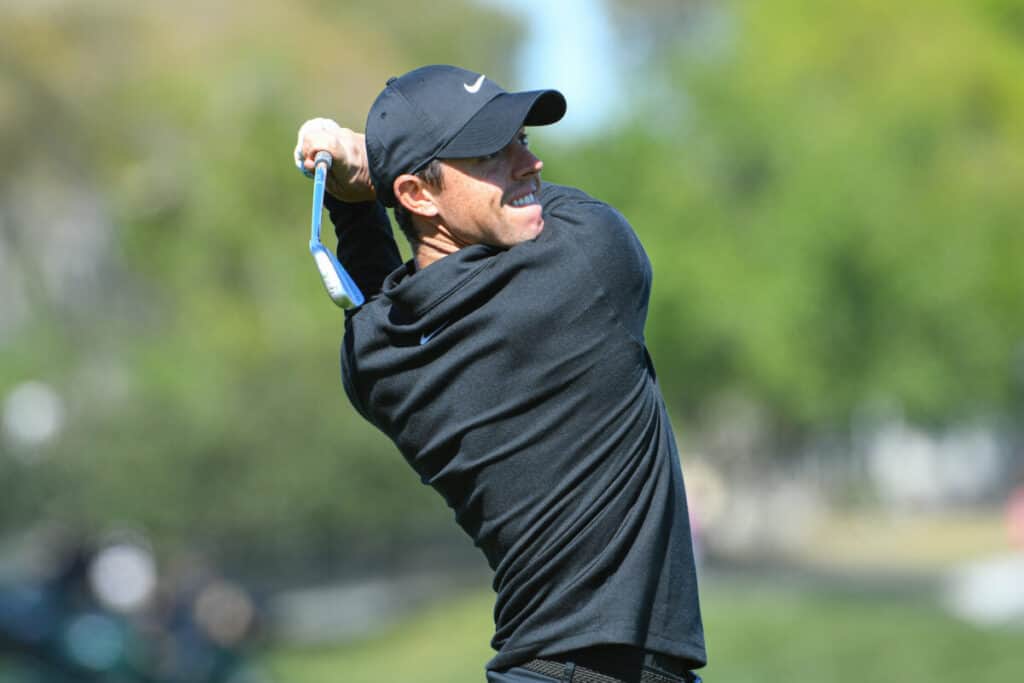
For example while one pro’s ‘gap wedge’ may be 50º another may choose 53 or even 54º for that same ‘gap wedge’ club and with such a difference in lofts it becomes very difficult to compare with any meaning how far the pros hit the same-named wedge.
Assuming however the pros are hitting ‘standard’ lofted pitching, gap, sand and lob wedges we found the following stock distances for how far the pros hit them .
As a whole PGA pros hit their pitching wedge an average carry distance of 141 yards. They hit 52º gap wedges a stock carry distance of between 126 and 135 yards and carry 56º sand wedges an average distance of 119 to 124 yards. Standard 60º lob wedges meanwhile carry 95 to 105 yards on average.
While these yardages will give you a general guide as to how far pros hit their wedges it is important to remember how particular all the pros are about these clubs especially.
It is vital for them to know exactly how far they hit their wedges with a variety of different types of shots because feel is so important from those short distances, especially at the top level of the game, where a yard or two can make the difference between winning or losing a tournament.
That is why you will find some pros’ wedges measured up to 0.5º or even 0.25º when listed and it is also likely that some of the actual strengths of the wedge lofts they use may in reality be stronger (i.e. a lower loft) or a touch weaker (i.e. a higher loft) than the actual degree loft number shown on their club.
To help however answer the question as well as we can the table below shows the varying distances some of the top pros, including Tiger Woods, Rory McIlroy and Dustin Johnson, are hitting their wedges, together with the degrees of loft their clubs are listed at.
Before you go …
While it is great to find out how far the top players are hitting the ball it is even better to know the reasons why they achieve the huge distances they get.
Is it simply down to the fact that they have access to the latest and best equipment or is it something else?
Read our next article to discover the real reasons the pros hit the ball as far as they do, and how you can potentially add 20 to 30 yards to your drives!
How Do Pros Hit the Ball So Far?
Other top articles related to this topic:
- How Far Should You Hit a Driver? FULL GUIDE By Age, Handicap etc.
- How Far Does a 3 Wood vs 5 Wood Go? Tee and Approach Shots!
- How Far Should I Hit My Hybrids? 2 vs 3 vs 4 Hybrid Distances
- Hybrids vs. Fairway Woods – FULL Distance and Comparison Guide
- How Far Should I Hit My Irons? By Handicap, Age & Swingspeed
- How Far Should You Hit Your Wedges? Be Sure to Fill the Gaps!
- Why Don’t Your Drives Go Far? Slow and Steady Loses the Race
- How Far Should Your Driver Swingspeed Go? 60 to 120 mph Guide
- Average Driver Swingspeeds? COMPLETE GUIDE by Age, Handicap etc.
- Ideal Spin Rate and Launch Angle for Driver? That’s Personal!
- How Far Should Your Ball Speed Go? 100mph All the Way to 210mph!
- The PGA Tour’s Rising Driver Ball Speeds Mean One Thing – $$
- What Should Your Driver Attack Angle Be? Try Not to Be Negative
- How Much Does Driver Loft Affect Distance? Loft is Dynamic Too!
- 10 Ways to Get More Distance off The Tee With & Without Speed!
- What Determines Driver Distance? Skill Triumphs Over All!
- Are Driving Range Distances Accurate? Golf Balls are a Problem
- Do All Golf Balls Go the Same Distance? Physics First
- What Affects Golf Ball Distance? Beware ALL the Uncontrollables!
- Do Certain Golf Balls Go Further? Brand and Cost Considerations
- Do Distance Balls Go Further? Marketing Matters
Leave a Reply Cancel reply
Your email address will not be published. Required fields are marked *
Save my name, email, and website in this browser for the next time I comment.
RECENT ARTICLES

Champions Hybrid Heroes. Most Used Hybrids by Champions Tour Pros (2024)

The Go-To Fairway Woods of Senior Tour Champions (2024)

Flexible Friends: Uncovering the Shafts Champions Tour Players Use (2024)

In the Bag: Unpacking the Clubs Champions Tour Players Use (2024)

Champions’ Choice: The Most Used Irons on the Champions Tour (2024)
LEGAL INFORMATION
This site is owned and operated by Golfing Focus Limited, a private limited company whose registered office is in London, UK. Golfing Focus Limited is a participant in the Amazon Services LLC Associates Program, an affiliate advertising program designed to provide a means for sites to earn advertising fees (at no cost to you) by linking to Amazon.com. Golfing Focus Limited also participates in other affiliate programs with the eBay Partner Network, FlexOffers, CJ.com, Svorn and other sites and is compensated for referring traffic and business to these companies (again at no cost to you).
Our Socials
TrackMan Average Tour Stats
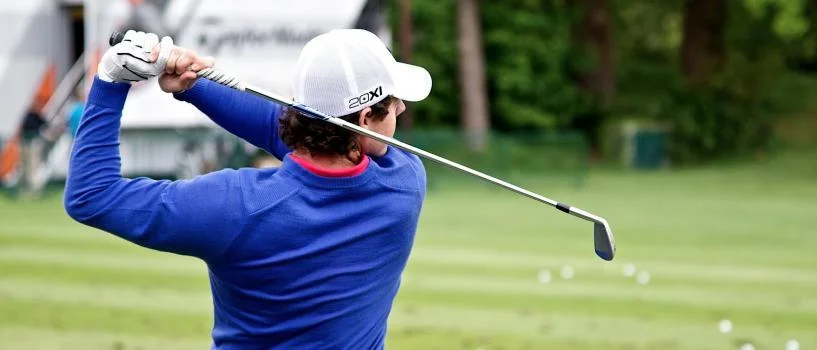
Tour stats include:
Club Speed, Attack Angle, Ball Speed, Smash Factor, Launch Angle, Spin Rate, Max Height, Land Angle and Carry.
TrackMan Average Stats Taken From The PGA TOUR
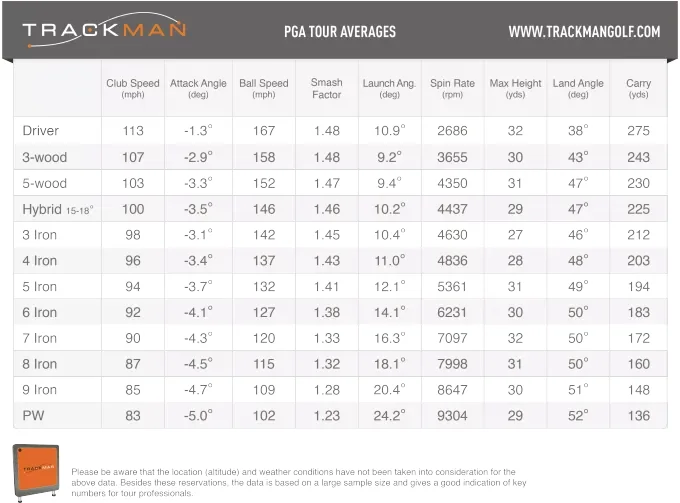
TrackMan LPGA Tour Average Stats
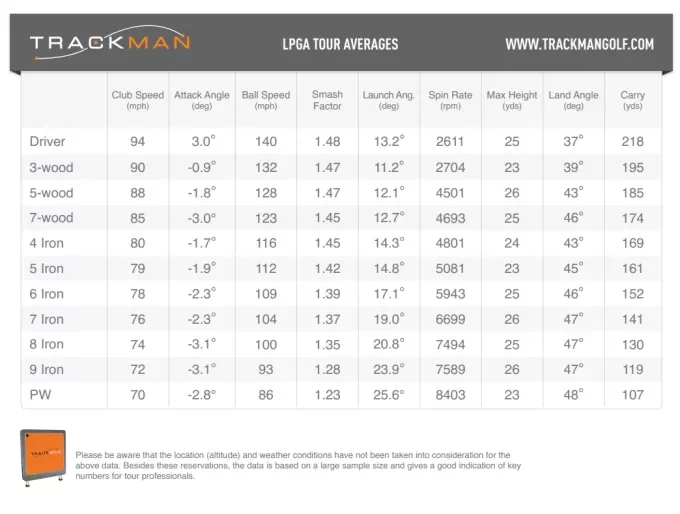
80 comments
So the average male Tour pro hits down on the ball slightly with the driver? Should attack angle vary with clubhead speed?
The attack angle for the pros varies on woods, but it’s more or less negative when it comes to hybrids and irons. For the average player, the attack angle on drivers varies and in general so should the ball that is hit from the ground always have a negative attack angle in order to get a better margin of error for the impact.
However, in order to get the longest carry possible, the ball should launch high with low spin. The optimal numbers are individual based on club speed – and that type of flight can easier be achieved if the spin loft is low together with a high dynamic loft. The more the attack angle is negative, then the higher the spin loft gets => the attack angle should be closer to 0 if anything IF the goal is to carry as long as possible.
But generally, the attack angle for irons should be from -2 – -5 for almost all players, but for drivers you can hit it further with a positive attack angle, no matter the club speed.
Niklas Bergdahl Support Manager EMEA & Asia
Can you send me the optimal numbers across the board that players and coaches should be looking for in lessons and trackman sessions
Strangely enough, with a driver you can achieve a carry of 300 vs 275 with the same clubhead speed of 113. Adam Young tries to get people to convert to this method. Attack angle = +8 degrees Launch angle = 19 degrees Backspin = 2,000 Smash Factor= 1.5
Hi. I can only confirm. I achieve those positive angles and l can carry the driver (9 degr loft) 245 yards with a club speed of 95mph. Rollout is average 20 yards.
No, it is 3° and that means the clubhead is movin upwards. – is downwards.
You are reading the LPGA (ladies) numbers Tim. The PGA (men) average is -1.3.
Looks like the average LPGA players trackman swing speed is more or less the same as an average 10 hcp male player. Though the ladies are a lot more skilled in hitting it on the right angles and in the right spot on the clubface. Would an average 10 hcp male player have a advantage or disadvantege using graphite shafts?
Harry, any player of any handicap can benefit from graphite shafts. More often than not, the memory in most players’ minds from graphite stems from a very long time ago when graphite was ONLY graphite. It was whippy, and not very accurate. Material advances and composite technology have nearly rendered steel obsolete. I say nearly, mind you. There are a number of outstanding graphite shafts out there that are super stable and responsive, enabling a lighter club and longer distance without sacrificing accuracy. Fujikura makes some really nice iron shafts that fuse both steel and graphite technologies called MCI. In fact, i have Fuji PRO 95i shafts in my irons and my iron game is better now than it ever was with steel. I’m a 3.5 index and relatively strong but it allows me to play all out without getting tired on the back 9 from heavy clubs. Being a club builder, i can tell you that in golf equipment there’s a trade-off in everything. wether it’s length, weight, or feel so your advantage or disadvantage is dependent on how precisely you build your piece of equipment.
Hey Chris thanks for the info below i find it very interesting. Curious do you have those same shafts in your wedges or do you have steel in your wedges? I played SteelFiber i95 shafts last year in all my irons including wedges. I liked them in my irons but i felt like it hurt my game in wedges. Do you have any thoughts on this? Thanks
Agreed. Shallow your angle of attack to match the LPGA players.
I have had a number of sessions on a Trackman, (the latest on Aug 22, 2015, at “Modern Golf” in Mississauga On.). My clubhead speed and distances are about the same as LPGA averages. I was doing wedge work, and see that for a pitching wedge, (48°), my angle of attack -about 7.5° – is n=much higher than LPGA average. My accuracy is good, (only 3 0f 19 shots more that 20′ away, and all when the face angle was over 4° closed). I’m thinking that I should weaken my left hand a bit, (it’s a little strong on pitch shots), and play the ball farther forward- 2″ ahead of centre. Am I on the right track, or will these changes introduce new problems?
I’m 74 years old, and am a long-time PGA of Canada member. Thanks for any feedback…. love Trackman outings.
I would recommend that you visit one of our certified coaches, he/she would be able to help you and find what numbers are best for you.
See our TrackMan Locator here.
I don’t disagree with these stats but I do it;s kinda weird. 87 miles mph with an 8 iron should produce 177 yards of carry not 160 that’s a lot of mph. Iv’e seen high school kids hit 9 iron 165 and they don’t swing 100 mph with a 9 iron. When I swing hard I hit my 8 iron 155 and my legit radar read 72 mph so logic would dictate at 88 mph you would get more like 180 yards carry again that’s a lot of mph.
Remember that’s a carry number not total distance. Also since the pros produce significant more back spin, their ball flight is higher, landing angle loftier producing minimum roll whereas your total distance might be benefiting from maximum roll. One more thing to check would be launch angle where you might be hitting a low ball flight to maximize distance which in my opinion is “cheating.”
The PGA Tour 8-iron goes 160 in the air for a couple of reasons. One, they usually hit weaker lofts than high school players (like I) do. Secondly, they spin their 8-iron at 7998 RPM to stop the ball on fast greens. I believe this is the combination that makes the 8-iron go so much shorter.
I’ve hit thousands of balls on Foresight simulators, and what I’ve found is that backspin significantly influences carry distance. Holding club head speed constant, greater backspin reduces carry distance on all clubs.
For mid-irons, I’d estimate that you lose roughly 5-7 yards of carry per 1,000 RPM in additional backspin. And with the driver it’s easily 10+ yards of carry lost per 1,000 RPM.
This explains why poorly struck balls will often fly as far, if not further, than a well-hit shot. The key to backspin is crispness of contact – a poorly struck shot simply won’t spin as much. Unless the impact is absolutely terrible, the lack of backspin on poorly struck shots will cause those balls to carry further than a well-struck ball. So if you’re flying balls over the green with your irons, the culprit could be too little backspin caused by poor contact, cheap balls, a dirty club face, etc.
I think this is also the key reason why fades don’t carry as far as draws. It’s not that a draw swing is any faster/more powerful – it’s simply that fades have more backspin due to the impact geometry/physics involved with that swing.
Now I may be wrong on some of this, so I’d love to get a true expert’s take.
One thing I forgot to add to my comment above is that you need a minimum of backspin on all golf shots just to get the ball up in the air. That may be 1,500 RPM for woods and maybe 3,000 for irons.
My point is that increasing backspin beyond this base level will generally reduce carry. For example, I can guarantee that increasing the backspin on your 7 iron from 5k to 7.5k will reduce your carry with that club, even if your swinging faster at 7.5k.
I totally disagree with your premise. Draws carrying further than fades? That makes no sense.
Bare in mind tour players play with proper golf clubs which are weak lofted so the people you see hitting a 9 iron further than tour average 8 it’s probably because that 9 iron is closer to a 7 iron loft
Spin determines weather you hit a draw or fade so logic would dictate distance will also be effected. In my experience draws do tend to be further for 2 reasons and both have to do with spin. With a draw you will usually get more roll out as well as flight because of the decrease in spin. This is especially true with a driver.
Depends what clubs you are using. There can be as much as 7 degrees of variation between a ‘standard’ loft on a 7 iron. If you’re playing the Callaway Mavrik irons, you’ll get 27 degrees of loft on a 7 iron. If you’re playing the Callaway Apex Pro then its 34 degrees. That’s a two club difference.
I was custom fit recently for the Apex 21’s and currently play Apex MBs. With the MBs my 7 iron has 34 degrees of loft and flies 165yds with 89mph average club head speed. Same swing with the Apex 21s (30 degrees of loft) flies between 177 – 180 yds. Big difference.
Larry , I would highly recommend you see Mark Evershed . Buy him lunch and get the answers your looking for .
Hi guys this was a recent session with a cobra 3 wood 16 deg loft.my question is my launch angle seems a little low ,interested in your thoughts .thanks Shot # Club Club Speed (mph) Ball Speed (mph) Smash Factor Launch Angle (degrees) Direction Back Spin (rpm) Carry Distance (yards) Total Distance (yards) 1 3 Wood 94 143 1.52 8.80 Straight 3874.00 215.00 232.00 2 3 Wood 98 148 1.51 9.10 Straight 4096.00 223.00 240.00 3 3 Wood 94 142 1.51 9.10 Straight 3904.00 213.00 230.00 4 3 Wood 94 143 1.52 8.80 Straight 3874.00 215.00 232.00 5 3 Wood 96 145 1.51 9.10 Straight 4000.00 219.00 236.00 6 3 Wood 94 143 1.52 8.80 Straight 3874.00 215.00 232.00 7 3 Wood 94 143 1.52 8.80 Straight 3874.00 215.00 232.00 8 3 Wood 93 141 1.52 8.80 Straight 3826.00 212.00 229.00 9 3 Wood 92 129 1.40 12.40 Straight 4138.00 190.00 207.00 10 3 Wood 94 142 1.51 9.10 Straight 3904.00 213.00 230.00 11 3 Wood 94 142 1.51 9.10 Straight 3904.00 213.00 230.00 12 3 Wood 94 143 1.52 8.80 Straight 3874.00 215.00 232.00 13 3 Wood 96 145 1.51 9.10 Straight 4000.00 219.00 236.00 14 3 Wood 93 140 1.51 9.10 Straight 3856.00 210.00 227.00 15 3 Wood 96 146 1.52 8.80 Straight 3970.00 220.00 237.00 16 3 Wood 92 140 1.52 8.80 Straight 3778.00 210.00 227.00 17 3 Wood 95 144 1.52 8.80 Straight 3922.00 216.00 233.00 18 3 Wood 96 145 1.51 9.10 Straight 4000.00 219.00 236.00 19 3 Wood 94 142 1.51 9.10 Straight 3904.00 213.00 230.00 20 3 Wood 91 137 1.51 9.10 Straight 3760.00 204.00 221.00 21 3 Wood 94 143 1.52 8.80 Straight 3874.00 215.00 232.00 22 3 Wood 95 144 1.52 8.80 Straight 3922.00 216.00 233.00 23 3 Wood 95 144 1.52 8.80 Straight 3922.00 216.00 233.00 24 3 Wood 96 146 1.52 8.80 Straight 3970.00 220.00 237.00 25 3 Wood 96 146 1.52 8.80 Straight 3970.00 220.00 237.00 26 3 Wood 96 145 1.51 9.10 Straight 4000.00 219.00 236.00 27 3 Wood 94 137 1.46 10.60 Straight 4054.00 204.00 221.00 28 3 Wood 94 143 1.52 8.80 Straight 3874.00 215.00 232.00 29 3 Wood 98 142 1.45 10.90 Straight 4276.00 213.00 230.00
What kind of balls were you using?
Brent. This was at a driving range with srixon range balls
Ok the one number that really stood out to me was the smash factor. Usually anything above a 1.50 indicates something is illegal. There’s a reason not even the PGA tour players aren’t averaging 1.50 off the tee. Other than that your numbers look good.
Brent what about the launch angle
Yes the launch is a little on the low side. But seeing how you’re still getting decent distance I wouldn’t worry too much about how it’s coming out. But try hitting down on the ball more to get it up in the air faster.
I frequently get above 1.5 on trackman with longer irons and my woods (I have raised this with your tech teams already). This is because your machine measures club speed just before impact and doesn’t detect acceleration through impact
Trackman doesn’t detect acceleration through impact on solidly struck shots so you can post smash factors above 1.5. It’s best to just rely on ball speed with Trackman
Brent in one of your comments you said my smash factor was high ,had a session last night at range and some of my smash factors were 1.53 is this something to try and change and if so how do I change it
Like you had said you were using range balls correct? If so the smash factor will be a little off since they aren’t a legal tournament ball. What the smash factor (as explained to me by the Carolinas PGA rules committee chairman) is, is a measurement of how well the ball comes off the face. There’s a specific calculation for it but I’m not positive of it and anything over a 1.50 usually is a tell tale sign that either the club or ball is illegal. What I would recommend doing is using the ball you would normally play a round with and get some readings off that ball.
I read not long ago that Rory Mcilroy had a smash factor of 1.53 as well . If Willie can hit it 380 the way Rory does, I wouldn’t change a thing.
Larry. I’m 55 years old 280 is my distance not 380 Like Rory
Ball speed divided by club head speed is smash factor
I’m currently doing my university project on green-side bunker shots, I was wondering if you have any shot data for a short bunker shot or flop shot? Thanks.
Sorry but we do not have any official data we can share, but it would be interesting to see your final research :)
Blair, My assumption would be that the cleaner a ball is picked out of a bunker the more spin it will have and vice versa. The more sand you use to move the ball the less spin.
Do you have TrackMan data for AoA and DL for greenside bunker shots?
Sorry we do not have any official bunker shot data.
In looking at the tour pro stats for men – the max height reading for all clubs is about 30 plus or minus 2. I am trying to understand how/why are the heights the same for all clubs? My assumption would be the more lofted the club the greater the height! Is 30ish the optimum figure for best distance? Because in my last stats my longest 9.5 degree driver shot was max height of 56!
Is there any data available from the Senior tour?
We do not have any official charts for the Senior Tour. But you can login on mytrackman.com and use the combine section and filter, to show only Senior Tour players.
Thanks Christian!
what month/year is this data from?
Is there any data on typical club path for a tour pro?
Can you please post stats for average path, club face, and face to path numbers for PGA tour?
Could you please post average path, club face, and face to path numbers for several top Tour Players?
Before all the hype about hitting up on the ball came about, I hit down on a driver anywhere from -2 to -4 degrees and swung 1-2 degrees left.
Once I started to try and swing up on it. I lost direction big time. An easy swing for me is 112, swinging hard at it I can get it up to 123. Does Trackman recommend those that have higher swing speeds to hit down on it for straighter direction?
There is no physics logic backing up that hitting up on the ball will give a decrease in accuracy. However to go from hitting down to hitting up you have made some changes to your impact obviously. The way you made the changes could well be the problem as this could have affected your impact location, swing path, clubface and the way you release the club
Can pga tour players carry the ball 293 yards.
A Question: Were some data change on this site? I ask because I’m quite sure to have read other data for the men’s driver trajectory. Am I wrong or can someone confirm this?
kindly zorro
Is my impression right, that the data for the men driver were changed from
[Daten alt: 112mph 165mph 11,2° 2685 31y 39° 269y] to [Daten neu: 113mph 167mph 10,9° 2686 32y 38° 275y] ?
Why did TM do that?
For the tour pro stats – mainly carry distance, launch angle and spin rate for the driver, you have the averages, could you supply the max and min (filtered for outliers)? I am going to run an experiment with Trackman at my golf academy and need a starting range for each item. The tour max and min range is a starting point versus having to create this from scratch.
Anyone know where I can find raw data of clubhead speed? It is for a College project. Thanks!
You know what would be great to see – average miss from target – left and right – for each club. Of course short and long from target matter as well, but solid contact isn’t really my issue – left and right misses is my challenge
I’m about a half club off of PGA Tour average distance wise. Technically I’m a 1 handicap, but more like 4 or 5 when the tourney pressure is on. I know from playing with better players the difference between me and them is pretty much how much more accurate they are from a left and right perspective.
You can find all this info from Mark Broadie. He has tracked all the shots on the us tour for years and also written a book Every Shot Counts about it
I have been playing Golf for less than 19 months. I must admit I was damn tired of the same Golf Lesson producing varying results with inconsistent instruction(s) which seemed contradictory to the previous lesson. I take Golf perhaps a little more serious than others and my “approach” to this game may be viewed as extreme due to my focus on Fitness/Strength Training combined with my Yoga and Nutritional regimen.
That notwithstanding I would like to formally THANK the Trackman Developers and Support Staff for FINALLY producing a “Standardized” curriculum eliminating the traditional random quick fixes and circumventing the often inconsistent and contradictory methods being taught today.
I currently own a Trackman 4 and although I DO NOT wish to teach, I am Certified as an Operator and successful in obtaining my Professional Level 1 & 2 Certifications and shortly will be submitting my Thesis to be considered for review. These Certifications have greatly assisted me in understanding Flight/Ball dynamics and greatly assists my Coach and I in our 4-5 hour daily Putting-Wedge-Iron-Wood and Driver Sessions providing the data necessary to produce a more consistent and …. I have a hard time with this next word…… F U N game. (There I said the word “fun” in the same sentence as “Golf.” I’m so proud of myself!!!
Seriously, I simply CANNOT thank Nathan Meyer for coming to my hometown and demonstrating the enormous benefit(s) of purchasing the Trackman 4 product.
Kym Fontana [email protected]
It has been an absolute pleasure getting to know you! Your work ethic, attitude, and kindness are all things that I can look up to. very excited for 2017 and I am looking forward to seeing you again soon!
-Nathan Meyer [email protected]
Are there numbers posted for an average 5 HCP player or 10 HCP player similar to the charts above for the ave tour player?
What is the #1 PGA Tour player in “Carry Distance” average carry distance??
I understand this data is pretty old, released soon after the time when trackman first came out. I’m sure things have changed since then. Any update?
Actually, we haven’t seen any huge changes over the past years, it’s more about roundings. For example, Avg. Club Speed for a driver: 2014: 113.0 mph 2015: 113.3 mph 2016: 112.9 mph And it’s pretty much similar with the other numbers.
We do have a graphical updated version of the Tour Stats here.
Not really. Lee Westwood was interviewed recently and advised that apart from his driver he hits everything else almost the exact same he has his entire career.
I’m looking for PGA tour averages for dynamic loft for different clubs. Does anyone have this data to share? Thanks!
Are there tour averages for club path?
Are all these stats full swings? Example: Would the avg tour pro hit a 6-iron further, if he turns fully and tries to hit it as far as possible (with a natural movement like on a driver – not with an unnatural swing that creates most possible power, but result in very unconsistent ball flight)?
Currently I practice indoors because of the winter. I do my practice with Trackman and I carry my 7 iron about 177-180 yards and total distance of 188-192 yards with my TaylorMade PSi irons. Lots of my shots with the 7 iron has a smash factor of 1.50-1.51.
This is a example of one of my shots with 7 iron.
Club speed: 80.2 | AoA: 1.3 | Ball speed: 120.5 | Carry: 164 meter | Total: 176 meter | Dyn Loft: 19.6 | Smash Factor: 1.50
Is that normal number for a 7 iron with a that club speed?
Averages are useful, but knowing them would be more useful if we knew the median and mode, as well as the range.
Hello, Are there updated PGA Tour Trackman stats?
On Trackman this week using 7i I noticed the spin rate I had was well below that of a pro by nearly 3,000 rpm but similar club speed and attack angle. How can I get my spin rate up?
It can vary a lot due to the ball and clubs you are using. For example driving range balls are normally very hard and will have much lower spinrates than a quality ball like a Titleist pro v1. Modern day irons are also built to higher the lauch angle and lower the spinrate so that the average golfer will achieve more distance
It would be great to know the average loft for each club, especially the irons!. I think 21-24-27-30-34-38-42-46 (3-Pw) are reasonable specs. What do you guys think?
What loft are the irons? A modern 7i is now 30°
Is this still the original data from 2015 or has it been updated?
I’d be very curious to see if the how the average attack angle has changed over this time in the PGA.
Please update this data from over the years of more testing.
Do you have any numbers on tour averages numbers on dynamic loft and spin loft?
I am a 2 handicapper and I hit my driver 280 yards on an average. What is the attack angle with driver of the best players on the pga tour?
these yardages are no doubt well below reality.
6 iron only 183yds carry? Most high handicappers hit it equally far.
Leave a Reply Cancel reply
- Coach Of The Month
Subscribe and get the latest Insights!
Recent comments.
- Keith Rogers on Paul McGinley – How To Practice
- Anthony on 6 TrackMan numbers all amateur golfers should know
- BillM on TRACKMAN HANDICAP
- Tim Work on How To Work On Attack Angle
- WAYNE B EISMAN on 6 TrackMan numbers all amateur golfers should know
Stay updated
Stay up to date and receive free notifications of new posts by email.
Email Address
Subscribe - It's Free!
- Coach of the month
REVEALED: PGA Tour average CARRY DISTANCES - how do YOURS compare?!
How far do you hit each of your clubs? See how you compare to the average PGA Tour pro.

Ever wondered how far the average PGA Tour pro carries the ball with each of the clubs in their bag? Well you're in luck as the table below gives you the latest numbers from the circuit.
Okay, not everyone hits the ball as far as the likes of Bryson DeChambeau - who incredibly once carried a drive last season 400 yards - but the below list at least gives you a broader idea as to how far the average PGA Tour pro is carrying their golf ball in 2021.

I know for one that GolfMagic Equipment Editor Alex Lodge, who plays off a low single-figure handicap, can hit the below numbers for fun - so some of you guys and girls out there may also be in the same boat.
Personally speaking, as a 14-handicap hacker, my total distances equate to the current carry distances of the average PGA Tour pro. But with a dodgy back and a few grey hairs starting to appear now, I will take that.
See how your carry numbers compare to the world's best on the PGA Tour in the table below, starting with the driver and moving down to the pitching wedge.
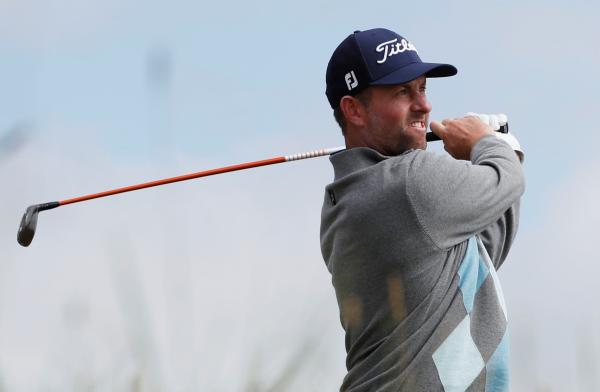
PGA TOUR AVERAGE CARRY DISTANCES 2021
DRIVER - 275 YARDS
3 WOOD - 243 YARDS
5 WOOD - 230 YARDS
HYBRID - 225 YARDS
3 IRON - 212 YARDS
4 IRON - 203 YARDS
5 IRON - 194 YARDS
6 IRON - 183 YARDS
7 IRON - 172 YARDS
8 IRON - 160 YARDS
9 IRON - 148 YARDS
PW - 136 YARDS
Stats: GOLFTV
How do your carry numbers compare to the averages on the PGA Tour? Come and share your thoughts over on our social media channels - Facebook, Instagram and Twitter - or head over to our YouTube channel.
Sponsored posts, latest news.

Latest Reviews
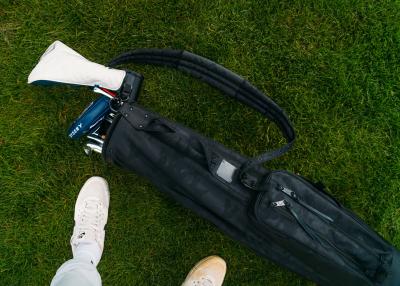
Golf Club Distances w/ Chart | Averages for Am & Pro Players
Last Updated on July 25, 2021
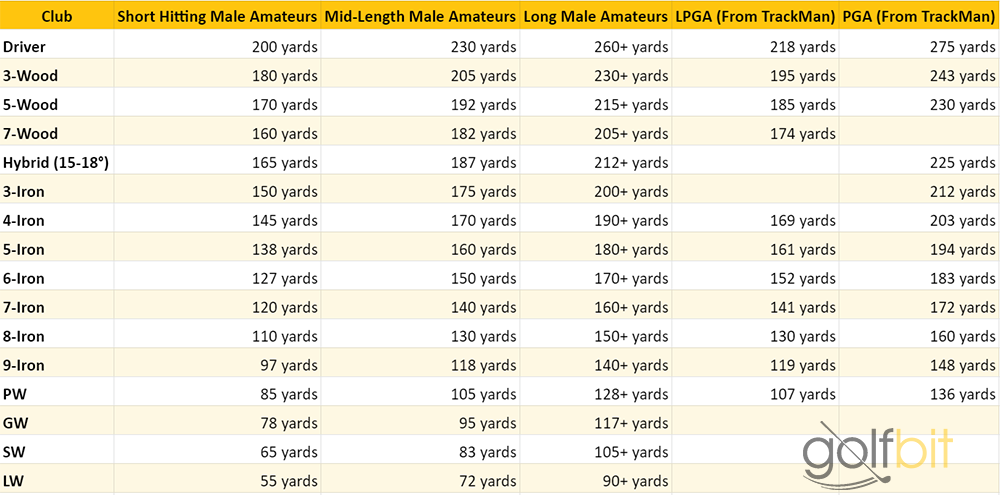
Distance is critical in golf. As golfers, we're always striving for more distance off the tee and consistent yardage gaps between the rest of our clubs.
In this guide, we'll break down how far amateur golfers of various skill levels and swing speeds hit each of their clubs to give you an idea of how you stack up. We've also included PGA and LPGA carry distance averages to see how you compare with the pros.
After that, we'll cover what factors affect your golf club distances and explain how to find out how far you hit each club.
Golf Club Distances Table
The table below shows how far golfers of various skill levels and swing speeds hit each club.
We've included PGA and LPGA carry distance averages of professional golfers that TrackMan gathered .
For amateur male golfers, we've split them into groups of "short," "mid," and "long" hitters. All distances refer to carry distance (distance until the ball first hits the ground) rather than total distance (carry and roll).
While TrackMan gathered extremely accurate data for LPGA and PGA carry distance averages, good data for amateurs is harder to come by.
There's a massive gap in skill-level and swing speeds among amateur golfers. Golfers of various handicaps also achieve their handicaps in a variety of ways. A 5-handicap golfer could be a super fast swinger in their athletic prime or a senior golfer who has lost distance over the years.
For our amateur short, mid, and long hitting male amateur distances, we relied on the limited available large sample data and what we've seen personally from loads of amateur golfers.
Because these yardages are for golfers of all ages, junior, middle-aged, and especially senior golfers may find themselves with distances closer to the "Short Hitting Male Amateurs" column. Most young adult to middle-aged male golfers should carry the ball to at least the "Mid-Length Male Amateurs" distances, while faster swingers of these ages can reach the distances in the "Long Male Amateurs" column.
Lastly, aside from LPGA professionals, we didn't include other female golfers in our distance table. There's even less data available for amateur female golfers than for male amateurs. We've also found a more considerable disparity in how far female recreational players hit the ball. Basically, we weren't confident we could provide any accurate/valuable information for female amateurs' distances.
What Affects Distance in Golf
There are a lot of factors that influence your golf club distances.
Club speed is the most significant factor in determining distance .
To illustrate this, look at the correlation of club head speed vs carry distance for PGA Tour players in the scatter plot below:

Assuming all other things are equal, more swing speed means more energy that can be transferred from the club to the golf ball, resulting in higher ball speed. Higher ball speed means the ball will travel a further distance.
Factors like impact location on the club face, club path, spin rate, and launch angle also play a large part in how far a ball travels.
Impact Location Golf Iron and Driver Sweet Spot
An impact out of the "sweet spot" of your irons or woods will lead to a higher smash factor than strikes that are too low, too high, off the toe, or off the heel.
Smash factor is a calculation of how well you converted club speed into ball speed (Smash Factor = Ball Speed / Club Speed).
In particular, strikes out of the heel and low strikes can kill distance with the driver.

If you struggle to consistently hit the ball with or near the sweet spot of your club face, you'll have issues with the consistency of your yardages.
Spin Rate and Club Path
Spin rate plays a large role in how far you'll hit the ball and the shapes of your shots.
A lot of golfers put too much spin on the ball with their driver either because of too much club loft, poor strikes (bad impact location), or poor club face control (the direction the club face is aimed relative to your swing path).
If you feel you're hitting the ball well but should be getting a few more yards, work with a club-fitter to see if your driver has too much loft. The ideal spin rate depends on your club speed , but too much spin will cost you yards.
Slices and hooks are caused by the club face being aimed too open ( slice ) or too closed ( hook ) relative to the club path. This can lead to both too much spin and the ball's spin axis being too strongly left-to-right or right-to-left.

If your club face is open (aimed right) relative to your club path, this can both cause too much spin and will cause the ball to spin too left-to-right on its spin axis . You'll lose a lot of yards from a slice as the ball travels left-to-right rather than straight.
Launch Angle
For each club, there is an optimal amount of spin and an optimal launch angle. Launch angle is the angle of a golf ball's initial ascent relative to the ground.
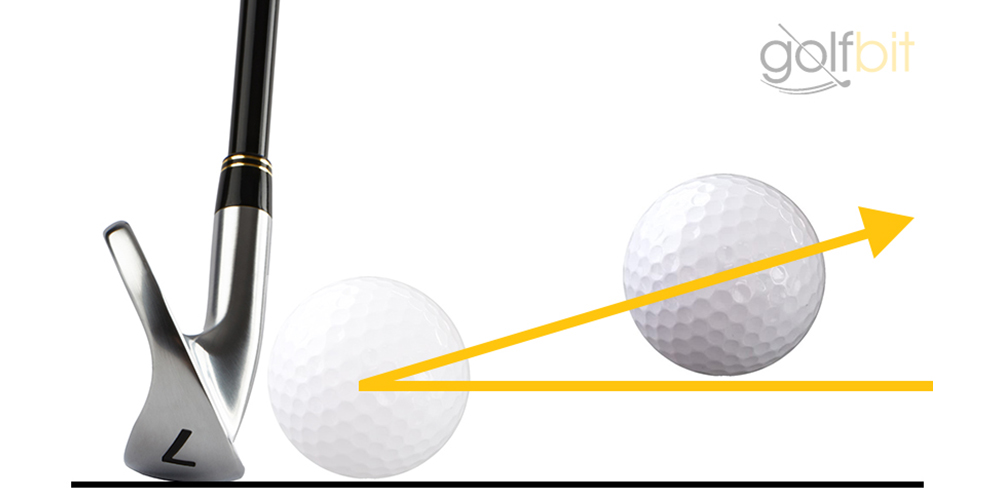
Launching the ball too high or too low will cost you distance.
While launch angle problems could be due to your swing, they can also be caused by playing the wrong clubs for your swing. If you feel like you're hitting the ball too high or too low, work with a club-fitter to dial in your clubs.
Factors Out of Your Control
There are also factors out of your control that can affect distance, like temperature and altitude.
Every 10 degrees that the temperature rises can easily lead to a couple of yards of additional ball flight with a driver.
If you drive the ball 240 yards at sea level, you will carry it around 255 yards in Denver's mile high altitude.
How to Find Your Distances
If you're looking to better understand how far you hit each club, we'd recommend purchasing a launch monitor or finding a range with a launch monitor.
To get accurate distances, you'll also want to make sure that you're hitting the same golf balls you normally play on the course.
Many golf ranges have cheap, inconsistent, or even balls purposefully made not to fly as far as normal golf balls.
Your typical range ball can easily cost you 10+ yards with the driver, while a limited flight range ball can lose you 30+ yards of distance with driver compared to a premium golf ball.
- Golf Terms Guide
- Golf Scoring Terms
- Best Golf Rangefinder
- What to Wear Golfing
- Terms of Service
- Privacy Policy
- Affiliate Disclosure
What Is the Average Distance With Each Golf Club?
This golf club distance chart can help your game
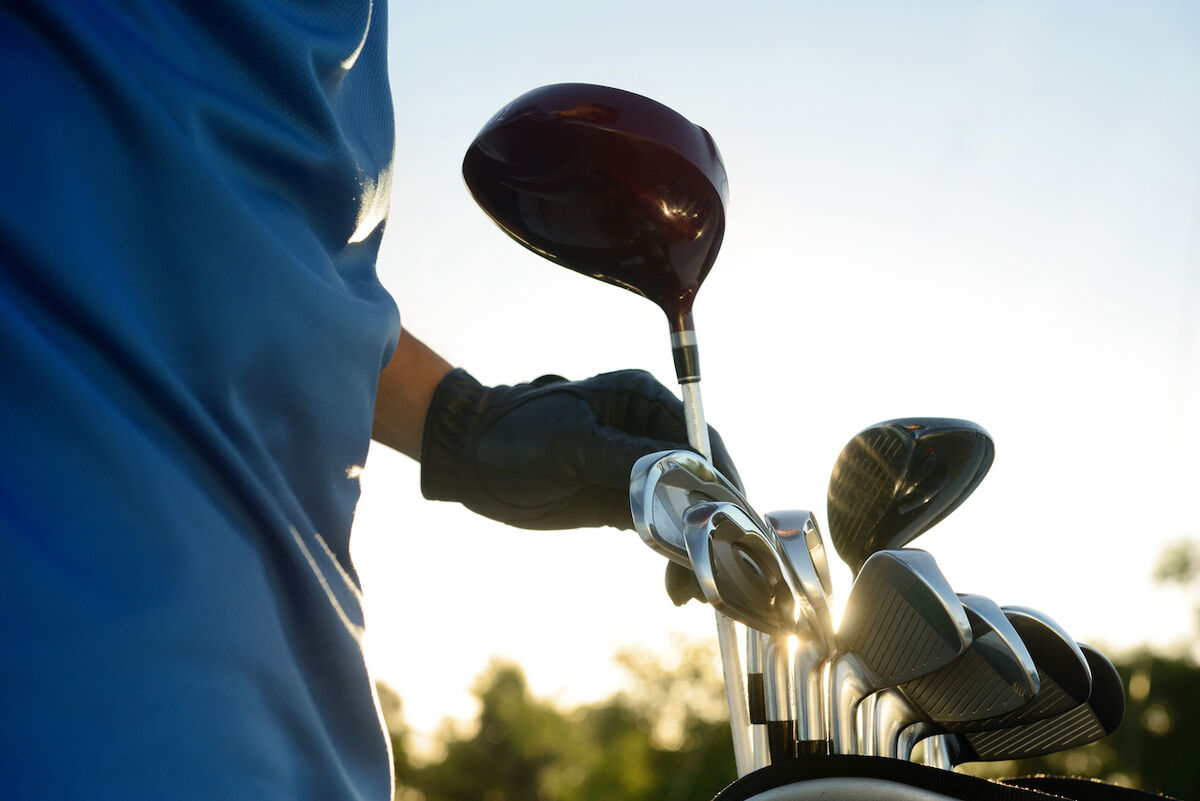
- DESCRIPTION Golfer pulling driver out of club bag
- SOURCE woraput/E+
- PERMISSION Getty Images License
The average distance golfers hit each club varies widely. A PGA Tour player hits a 7-iron between 172-215 yards. Meanwhile, a short-hitting amateur male golfer averages 120 yards with the same club.
Average Golf Club Distance Chart
Here's how far mid-handicap male golfers can expect to hit each club. Of course, specific distances for each individual player will vary based on several factors, which we'll detail shortly.
According to the USGA, golf’s governing body in the United States, the average male amateur golfer hits driver 217 yards , as recently as 2019. That same year, the PGA Tour average driving distance was 293.9 yards. Men, women, seniors, juniors, professionals, amateurs and beginners all hit their clubs different distances. The following golf club distance charts break down the average distances of golfers at many different levels of the game.
Key Factors to Achieve Distance
The total distance achieved by a golf club is based on several factors, including swing speed, the club’s loft, the carry distance achieved (Note: The carry distance is the yardage from the point of impact to the point of landing.), and even the weather.
Swing Speed
The faster your swing speed, the greater the distance. According to TrackMan , the average PGA Tour player has a driver club speed of 113 MPH, resulting in a 275 yard carry. Meanwhile, LPGA Tour players average 94 MPH with driver, and carry the ball 218 yards.
Since we know that amateur male golfers hit driver an average of 217 yards, we can infer that average male golfers and LPGA Tour players have similar swing speeds, making the LPGA Tour average distances with each club a good benchmark for average amateur male golfers.
Each club face has a unique loft. For example, a driver is designed for distance and usually has only 8-13 degrees of loft. In comparison, a pitching wedge is designed to get airborne, with 41-46 degrees of loft .

How to Accurately Measure How Far You Hit Your Clubs
According to thegolfmentor.com , distances achieved by short, mid and long hitters can vary by as much as 50% depending on the club and the gender (see actual average distance ranges below). Men tend to have faster swing speeds and hit the ball farther. However, many women are long hitters, with some LPGA pros hitting the ball as far, or farther, than men.
Distance can be greatly affected by the weather conditions. Hitting a ball into a strong wind will greatly influence distance, and a dry golf course will give you more roll, and therefore more distance, than a soggy course.
Average Distances for Men
Average distances for senior tour players.

The 10 Best Drivers for Senior Golfers in 2023 for Huge Distance
Average Distances for PGA Tour Players
Average distances for women.
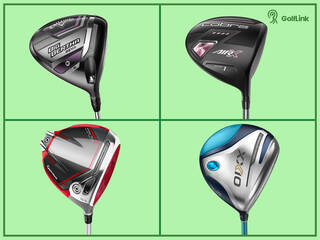
The 9 Best Drivers for Women of 2023
Average Distances for LPGA Tour Players
Tip: chart your distances for all your clubs.
Keep track of your average golf stats and scores with GolfLink's personalized game tracker. Sign up for free and create yours now!
Go to the driving range and hit ten golf balls with each club. Keep track of the ten distances you achieve with each club. Repeat the charting monthly, or more frequently if you are actively working on your swing.
The distance achieved by a specific golf club will vary from player to player and from day to day based on the conditions. Tour distance information was compiled from stats on pgatour.com, lpga.com, TrackMan.com and golfwrx.com.
Game Changers
How driving distance has changed over the past 40 years on the pga tour.
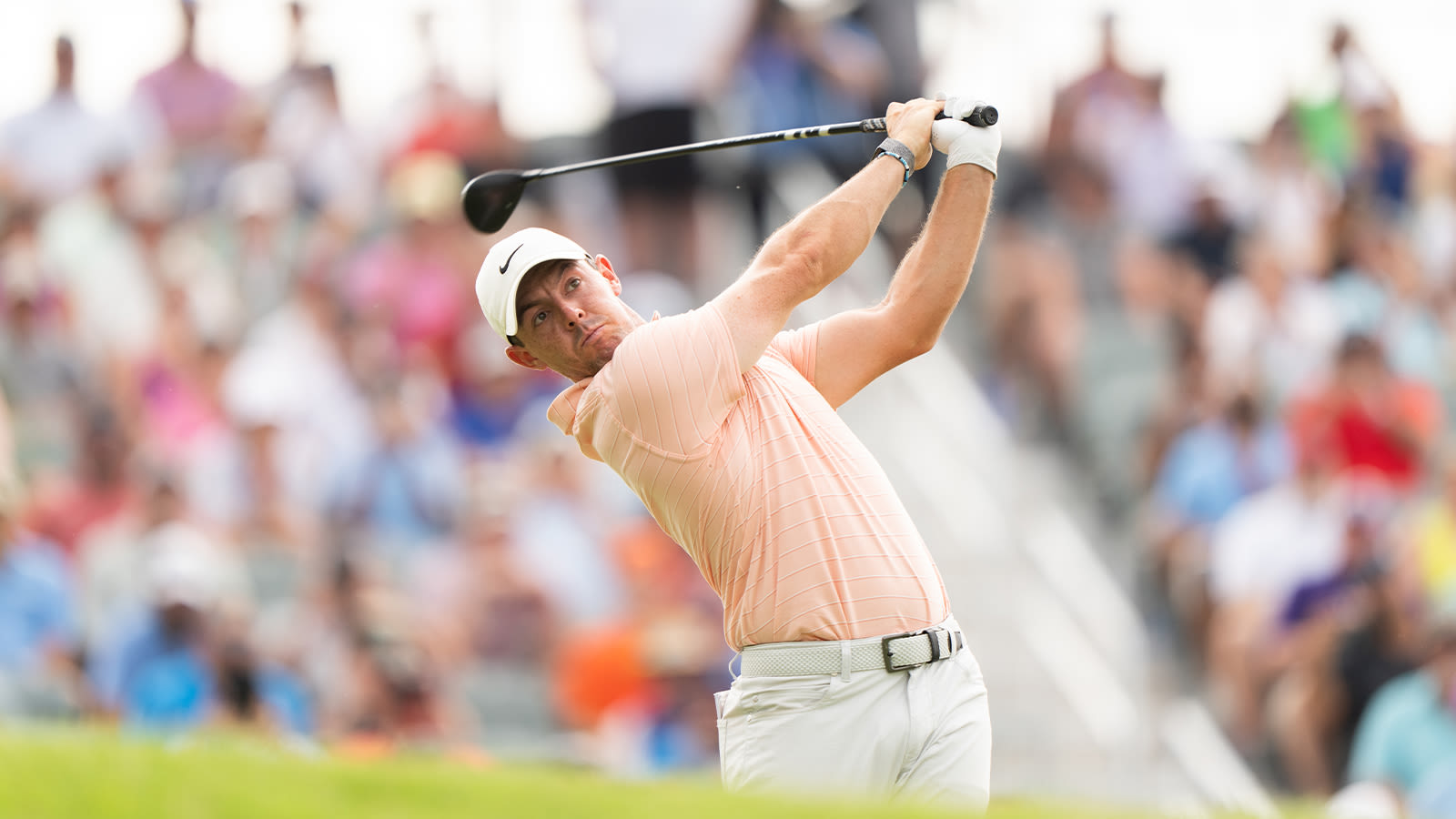
Rory McIlroy of Northern Ireland hits his shot from the tenth tee during the second round of the 2022 PGA Championship at the Southern Hills on May 20, 2022 in Tulsa, Oklahoma. (Photo by Darren Carroll/PGA of America)

We Can Learn from Rory's Admission; Make Sure The Changes You’re Making Fit Your Golf Game

Hit it Longer off the Tee with Joanna Coe

Adding Distance Off the Tee Like Cameron Champ Will Help Your Golf Game
Year - average distance (yards) | leader - leader's average.
- 2023 - 297.2 | Leader: Rory McIlroy - 326.6
- 2022 - 299.8 | Leader: Cameron Champ - 321.4
- 2021 - 295.3 | Leader: Bryson DeChambeau - 320.8
- 2020 - 296.4 | Leader: Bryson DeChambeau - 322.1
- 2019 - 293.9 | Leader: Cameron Champ - 317.9
- 2018 - 295.29 | Leader: Trey Mullinax - 318
- 2017 - 292.79 | Leader: Rory McIlroy - 316.7
- 2016 - 291.06 | Leader: J.B. Holmes - 314.5
- 2015 - 290.21 | Leader: Dustin Johnson - 317.7
- 2014 - 289.85 | Leader: Bubba Watson - 314.3
- 2013 - 288.00 | Leader: Luke List - 306.3
- 2012 - 290.07 | Leader: Bubba Watson - 315.5
- 2011- 291.14 | Leader: J.B. Holmes - 318.4
- 2010 - 287.49 | Leader: Robert Garrigus - 315.5
- 2009 - 288.07 | Leader: Robert Garrigus - 312
- 2008 - 287.74 | Leader: Bubba Watson - 315.1
- 2007 - 289.08 | Leader: Bubba Watson - 315.2
- 2006 - 289.35 | Leader: Bubba Watson - 319.6
- 2005 - 288.88 | Leader: Scott Hend- 318.9
- 2004 - 287.32 | Leader: Hank Kuehne - 314.4
- 2003 - 286.30 | Leader: Hank Kuehne - 321.4
- 2002 - 279.84 | Leader: John Daly - 306.8
- 2001 - 279.35 | Leader: John Daly - 306.7
- 2000 - 273.18| Leader: John Daly - 301.4
- 1999 - 272.45 | Leader: John Daly - 305.6
- 1998 - 270.63 | Leader: John Daly - 299.4
- 1997 - 267.67 | Leader: John Daly - 302
- 1996 - 266.49 | Leader: John Daly - 288.8
- 1995 - 263.55 | Leader: John Daly - 289
- 1994 - 261.84 | Leader: Davis Love III - 283.8
- 1993 - 260.36 | Leader: John Daly - 288.9
- 1992 - 260.52 | Leader: John Daly - 283.4
- 1991 - 261.44 | Leader: John Daly - 288.9
- 1990 - 262.75 | Leader: Tom Purtzer - 279.6
- 1989 - 261.81 | Leader: Ed Humenik - 280.9
- 1988 - 263.50 | Leader: Steve Thomas - 284.6
- 1987 - 262.50 | Leader: John McComish - 283.9
- 1986 - 261.58 | Leader: Davis Love III - 285.7
- 1985 - 260.18 | Leader: Andy Bean - 278.2
- 1984 - 259.61 | Leader: Bill Glasson - 276.5
- 1983 - 258.65 | Leader: John McComish - 277.4
- 1982 - 256.89 | Leader: Bill Calfee - 275.3
- 1981 - 259.66 | Leader: Dan Pohl - 280.1
- 1980 - 256.89 | Leader: Dan Pohl - 274.3
PGA of America
The PGA of America is one of the world's largest sports organizations, composed of PGA of America Golf Professionals who work daily to grow interest and participation in the game of golf.
Average Distance for Each Golf Club: Data for Amateurs vs PGA Tour Players

For many golfers, distance off the tee box is one of the most alluring parts of the game. Who doesn’t love smashing a 300-yard drive down the fairway? But do you know the average distances for each golf club based on real data? How do your driving distances stack up against benchmarks for amateur male golfers? And how far are the pros really hitting it on the PGA Tour?
This article will provide average carry distance ranges for male amateur golfers for every club – from driver down to pitching wedge. We’ll also look at Trackman distance statistics for PGA Tour players. Understanding these yardages can help you evaluate your distances compared to averages and set reasonable goals for improvement.
However, keep in mind that a wide range of factors impact how far you can hit each golf club. As we’ll discuss later, elements like your swing speed, launch angle, spin rate, and equipment have a significant influence on distance. So, instead of rigidly trying to match “average” numbers, focus on understanding your personal yardages and how to optimize them.
Table of Contents
Average Driving Distance by Club for Male Amateur Golfers
Let’s start with a breakdown of average driving distance by club specifically for male amateur golf players. These ranges account for differences in age, swing speed, and handicap, but are based on comprehensive data reporting:
Driver: 220-260 yards
The driver, as you’d expect, travels the farthest. But there’s a wide range based on swing speed. Slower swing speeds around 85 mph will carry around 220 yards, while those over 100 mph can average 260 yards.
3 Wood: 190-230 yards
Similar to the driver, 3 woods cover quite a distance spectrum. For slower swing speeds, expect a carry around 190 yards, extending to 230 yards for those with tour-level clubhead speed.
5 Wood: 180-210 yards
The 5 wood sits squarely between the 3 wood and hybrid club. For many golfers, this club is a fairway wood off the tee or for reaching long par 5s in two.
4 Hybrid: 170-200 yards
The hybrid has become a versatile favorite thanks to its forgiveness and ball flight. The averages span from 170 yards for slower swingers up to 200 for those with above-average clubhead speed.
5 Hybrid: 160-190 yards
Similar to the 4 hybrid, these clubs bridge the gap nicely between your fairway woods and long irons. They excel from tough lies.
6 Iron: 145-175 yards
Now transitioning to the irons, the 6 iron is the longest in your bag. But most amateur golfers will carry this club between 145-175 yards depending on their iron consistency and speed.
7 Iron : 130-160 yards
The 7 iron covers an average range between 130 to 160 yards based on swing speed and other factors. This club is a trusted option on long par 3s.
8 Iron: 115-145 yards
Moving down into the mid-irons, the 8 iron carries between 115 to 145 yards on average. It’s very versatile for a wide range of approach shots.
9 Iron: 105-135 yards
The yardages are dialing down as we progress through the bag. Expect carry distances from 105 to 135 yards with the 9 iron.
Pitching Wedge: 90-120 yards
The pitching wedge is an important club for shots around the green. Carry distance averages range from 90 to 120 yards.
Sand Wedge: 75-105 yards
The sand wedge, as the name indicates, is ideal for greenside bunkers. But it’s also great for short pitch shots. Average carry spans 75 to 105 yards.
Lob Wedge: 65-95 yards
With the most loft, the lob wedge offers control on the shortest shots. It covers carry distances from 65 to 95 yards on average.
Putt/Chip: 10-50 yards
While not a specific club, the putter and chipping clubs are vital for scoring close to the green. In the hands of a skilled golfer, these can consistently cover 10 to 50 yards.
So those are general benchmark yardages for male amateur golfers across the full bag, accounting for variance in swing speed and handicap. But you might be wondering – how much farther are the pros really hitting it compared to average? Let’s take a look.
PGA Tour Driving Distance Averages by Club
Thanks to precise shot data from Trackman, we can analyze the actual carry distance averages for PGA Tour players by club. Here is a breakdown of their elite driving distance yardages:
Driver: 292 yards
The PGA Tour average for driver carry distance is an incredible 292 yards. For context, that’s around 40 yards longer than a male amateur with an above-average swing speed.
3 Wood: 273 yards
The second longest club for Tour pros is the 3 wood, averaging 273 yards of carry – over 50 yards longer than an above-average amateur!
5 Wood: 258 yards
The 5 wood creeps down under 260 yards carried on average for PGA Tour players. But still far ahead of 200 yards for even above-average amateurs.
4 Hybrid: 243 yards
For the versatile hybrid, the PGA Tour average carry is 243 yards. That’s up to 80 yards more than an average male amateur golfer.
5 Hybrid: 232 yards
Similar story for the 5 hybrid, with PGA Tour shot data showing an average of 232 yards carry distance.
6 Iron: 219 yards
Now looking at the irons, the Tour average for a 6 iron is an impressive 219 yards carried. That’s around 50 yards longer than an above-average male amateur.
7 Iron: 204 yards
For the 7 iron, PGA Tour players achieve an average carry distance of 204 yards – significantly farther than most amateurs.
8 Iron: 188 yards
The 8 iron average drops under 190 yards carried for Tour pros. But still a major distance edge over male amateur golfers.
9 Iron: 173 yards
Getting nearer the green, the PGA Tour average for a 9 iron is 173 yards carry. That’s up to 60 yards longer than an average male amateur.
Pitching Wedge: 157 yards
The Tour average carry distance for a pitching wedge is 157 yards. Most amateurs will carry their pitching wedge under 120 yards.
So across the bag, the game’s top professionals are averaging between 40 to 80 yards more carry distance per club compared to above-average male amateurs. Factors like superb swing mechanics, speed training, optimized equipment, exceptional fitness, and many years of experience contribute to these distance gains.
But while it’s interesting to compare your driving distances to these benchmarks, it’s most important to know your personal yardages so you can make smart decisions on the course. And there are several steps you can take to increase driving distance if you choose to make that a goal – which we’ll cover next.
7 Tips to Increase Your Driver Distance
If you want to hit the ball farther than your current averages, here are 7 tactics to gain legitimate yards:
1. Chart Your Carry Yardages
First, you need to have a solid baseline understanding of your personal carry distances. At the driving range, hit 5-10 shots with each club and take the average distances. The key is measuring carry distance, not including roll-out. Track your averages over time to measure progress.
2. Improve Your Swing Mechanics
One of the biggest opportunities for extra distance is optimizing your swing technique. Common issues like casting, scooping, slicing, and poor weight transfer can rob you of yards. Take lessons to iron out any major swing flaws.
3. Do Strength Training & Flexibility Exercises
Building golf-specific muscle strength centered around your core, legs, and rotational movement can boost clubhead speed. Also, improve flexibility in your hips, torso, and shoulders to maximize your rotational power.
4. Get Fitted Properly for Your Equipment
Making sure your clubs are fit for your personal swing characteristics can pick up distance through optimized launch conditions. New club technology can also help, like woods with lower spin and adjustable hosels.
5. Increase Your Swing Tempo
The sequence of your swing tempo influences clubhead speed. A smooth transition between your backswing, downswing, and follow through builds momentum through the ball. Practice drills to find your optimal tempo.
6. Use Training Aids to Develop Speed
From weighted clubs to impact bags to wrist strengtheners, golf training aids can help ingrain a faster , more powerful swing. Use them along with your normal range sessions.
7. Try the Latest Equipment for Technology Gains
Club and ball manufacturers are always seeking to push distance limits through technology. Experiment with the newest drivers, fairway woods, hybrids, and golf ball designs to pick up extra yards.
Making swing changes does require patience. But implementing some of these tips consistently over a period of months can definitely help you gain distance compared to your current averages.
Final Takeaways
We covered a lot of ground on golf club distance averages, comparing male amateur driving distances to PGA Tour players. Here are some final key takeaways:
- Average carry distance for each club varies widely based on factors like swing speed, launch, shaft, and fitness. Focus on knowing your personal yardages.
- PGA Tour players drive the ball incredibly long thanks to optimized swings, training, equipment, and athleticism. Don’t expect to match their distances as an amateur.
- If you want to gain distance through training, be sure to make changes gradually over time to ingrain new swing techniques.
- While distance is alluring, remember that short game, course management, and putting account for lower scores. Don’t chase distance at the expense of your weaknesses.
- Setting reasonable goals and matching clubs to your current capability is more important than rigidly trying to hit “average” yardages. Play smarter and swing within yourself.
Golf is an endearingly challenging game with so many variables to manage. But keeping your distances dialed in for each club can help decision making on the course. Stick to the tips that work best for your game and fitness level. Trust your instincts. And keep practicing with the purpose of charting improvements over time.
With an optimized game that matches your abilities, you’ll find more fairways, drain more putts, and hopefully lower your handicap – no matter how far you hit it!
Zeen is a next generation WordPress theme. It’s powerful, beautifully designed and comes with everything you need.
How Far Do PGA Tour Pros Hit The Ball?
Whether you like it or not, distance is always talked about. But how far do PGA Tour pros hit the ball? Let's find out
- Sign up to Golf Monthly Newsletter Newsletter
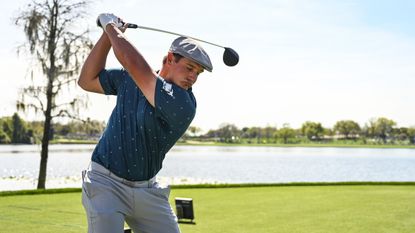
Distance is a hotly debated subject and not just in the clubhouse at your local municipal. So much so, earlier this year, the United States Golf Association (USGA) and R&A sent an official notice to equipment manufacturers, detailing new areas of interest in the distance debate.
The notice did not include any official changes to the Rules of Golf but it did give a glimpse into the future and just how they intend to stop the ever increasing trend of further drives and lengthening of golf courses.
As the general consensus is that PGA Tour pros hit the ball too far, do you know how far they actually hit it? Well, let's take a look.
The PGA Tour collates this information under the Driving Distance category. The average number of yards per measured drive is recorded on two holes per round. The PGA Tour accounts for possible variance, such as elevation and wind, and take care to counteract this effect in the chosen holes. The drives are measured at the point in which the ball come to rest regardless of whether it is in the fairway or not.
Cameron Champ leads the 2022 Driving Distance category with a whopping average of 326.1 yards. The American maintains a rather comfortable lead with Matt Wolff some 5.4 yards behind - averaging 320.7 yards off the tee.
The 5.4 yard difference between Champ and Wolff separates Wolff and Luke List; who is twelfth in the Driving Distance category - averaging 315.4.
The PGA Tour average driving distance is 298.4 yards; which is enough to rank 106th in the category. Notable players that fall beneath Tour average are Matt Fitzpatrick, who came agonisingly close to his first Major at the PGA Championship, Russell Henley, Billy Horschel, Abraham Ancer and Daniel Berger.
Get the Golf Monthly Newsletter
Subscribe to the Golf Monthly newsletter to stay up to date with all the latest tour news, equipment news, reviews, head-to-heads and buyer’s guides from our team of experienced experts.
What Is The Longest Drive Ever Hit On The PGA Tour?
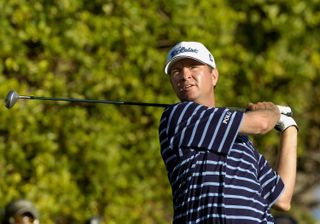
Unfortunately, this isn't as easy to answer as you might think.
The PGA Tour introduced ShotLink in a limited capacity in 2000. Since 2003, they have used the laser-based system to gain precise measurements on every hole - something which was not possible before.
Prior to 2003 and the expanded use of ShotLink, Tiger Woods hit a 498-yard drive on the 18th hole at the Plantation Course at Kapalua during the 2002 Mercedes Championship. Sadly for Woods, this is classed as an 'unofficial record.'
David Love III takes the spoils in the post-2003 era having driven one 476-yards on the exact same hole as Woods during the 2004 edition of the Mercedes Championship. Those familiar with the event will be aware of the cambering fairway that can be used to the players advantage.
Perhaps the most impressive drive recorded was by Jeff Sluman, who, at 5 foot 8 inches tall, put one out there 473-yards at the PGA West course during the 2003 Bob Hope Chrysler Classic. Pound for pound, that is an extremely long drive.

Driving Distance Analysis Through The Years
- The 2022 leading average driving distance is the longest in the last ten years
- The 2022 tour average driving distance is the longest in the last ten years
- The difference between the longest and tour average was the biggest in 2015 (28 yards)
- The difference between the longest and tour average was the second biggest in 2022 (so far - 27.7 yards)
- The average driving distance has increased 11.2 yards in the last ten years

Driving Distance Leaders Through The Years
In 2003, Hank Kuehne averaged a staggering 321.4 yards off the tee. Only Bryson DeChambeau (2020 & 2021) has bettered that total across a full PGA Tour season.
James joined Golf Monthly having previously written for other digital outlets. He is obsessed with all areas of the game – from tournament golf, to history, equipment, technique and travel. He is also an avid collector of memorabilia; with items from the likes of Bobby Jones, Tiger Woods, Francis Ouimet, Arnold Palmer, Lee Trevino, Adam Scott and Ernie Els. As well as writing for Golf Monthly, James’ golfing highlight is fist bumping Phil Mickelson on his way to winning the Open Championship at Muirfield in 2013. James grew up on the east coast of England and is the third generation of his golfing family. He now resides in Leeds and is a member of Cobble Hall Golf Club with a handicap index of 1.7. His favourite films are The Legend of Bagger Vance and Tin Cup.
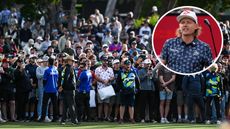
If anyone doubted The Australian's cult status Down Under, these pictures from LIV Golf Adelaide should clear it up...
By Jonny Leighfield Published 26 April 24

We all know that a GPS app can give you yardages, but can they actually improve your game and how else could one help?
By Joe Ferguson Published 26 April 24
- Contact Future's experts
- Terms and conditions
- Privacy policy
- Accessibility statement
- Cookies policy
- Advertise with us
Golf Monthly is part of Future plc, an international media group and leading digital publisher. Visit our corporate site . © Future Publishing Limited Quay House, The Ambury, Bath BA1 1UA. All rights reserved. England and Wales company registration number 2008885.
Zurich Classic of New Orleans
TPC Louisiana
USGA/R&A release latest Distance Report: Here's what the numbers mean

Andrew Redington
While Wednesday’s announcement that the USGA and R&A have narrowed their focus on ways to dial back distance at the elite level might have gotten all the attention, the ruling bodies also issued their annual Distance Report at the same time.
In its simplest interpretation, the Distance Report has been used to chronicle the imbalanced role distance is playing at the elite level. At first glance, this latest report may not have been the most convincing document. Year over year, driving distance on the PGA Tour, the European Tour (now DP World Tour), the Korn Ferry Tour and the Japan Golf Tour decreased in 2021 compared to 2020. And while average distances on the PGA Tour Champions, LPGA Tour and LET showed increases, each was below or just fractionally above their respective all-time highs.
But the point the ruling bodies want to make with the document is the overall trendline, which clearly has been much more upward than stable over the last 30 years. The reports use 2003 as a benchmark since that marks the first full year after the ruling bodies issued a Joint Statement of Principles that put elite driving distances on notice.
MORE: The first step in a rollback? Governing bodies announce plan in curtailing distance
Since 2003, according to their research, the average driving distance has increased 3.2 percent from 2003-2021. Moreover, the document makes the case that the PGA Tour statistic measuring all drives (compared to the metric that only accounts for two measured holes) was up 1.5 yards to an all-time high of 289.9 yards. Still, on the measured holes on the PGA Tour, 97 percent of the shots were hit with a driver, validating that number as the best indicator of where distance truly stands.
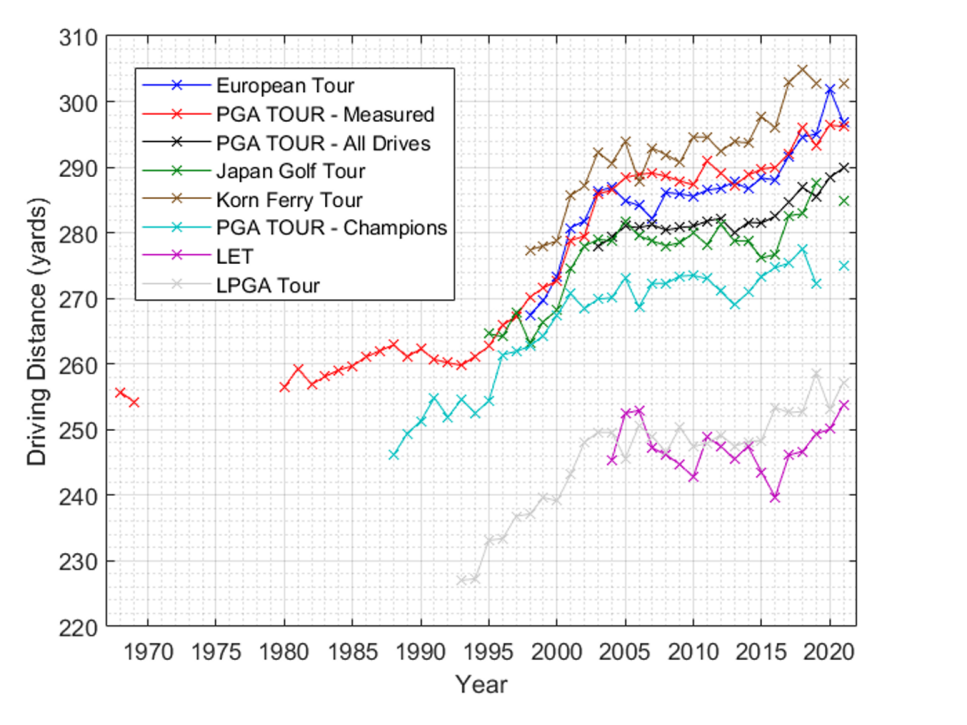
Also, not surprisingly, the bulk of drives are getting longer, according to the report. Since 2003, the percentage of drives less than 280 yards has decreased on both the PGA Tour and European Tour, while the percentage of drives greater than 300 yards has increased. In 2003, about 40 percent of drives recorded on the PGA Tour and European Tour were 280 yards and less, while slightly more than a quarter of drives exceeded 300 yards. By 2021, those percentages had more than flipped. In 2021, less than a quarter of drives didn't reach 280 yards, while about 43 percent were longer than 300.
The Distance Report also details data on PGA Tour clubhead speed, ball speed, launch angle and distance. Since 2003, average clubhead speed is up two mph, ball speed is up five mph, launch angle is slightly down and average spin rates also have decreased. In 2021, the average launch angle (10.5 degrees) and spin rate (2,527 rpm) were close to USGA golf ball testing averages (10 degrees, 2,520 rpm). While the average clubhead speed was 115.1 mph—about five mph short of the current clubhead speed used in the ball test—the 90th percentile for clubhead speed (120.1 mph) is now right in line with that test speed.
The Distance Report also tracks the changes in scoring average across all tours. While it, too, reflects improvement in the last 40 years, the report characterizes scores showing a "slow creep downward" of .04 strokes per year since 1980. Since 2003, it shows the scoring average on the PGA Tour is essentially unchanged.
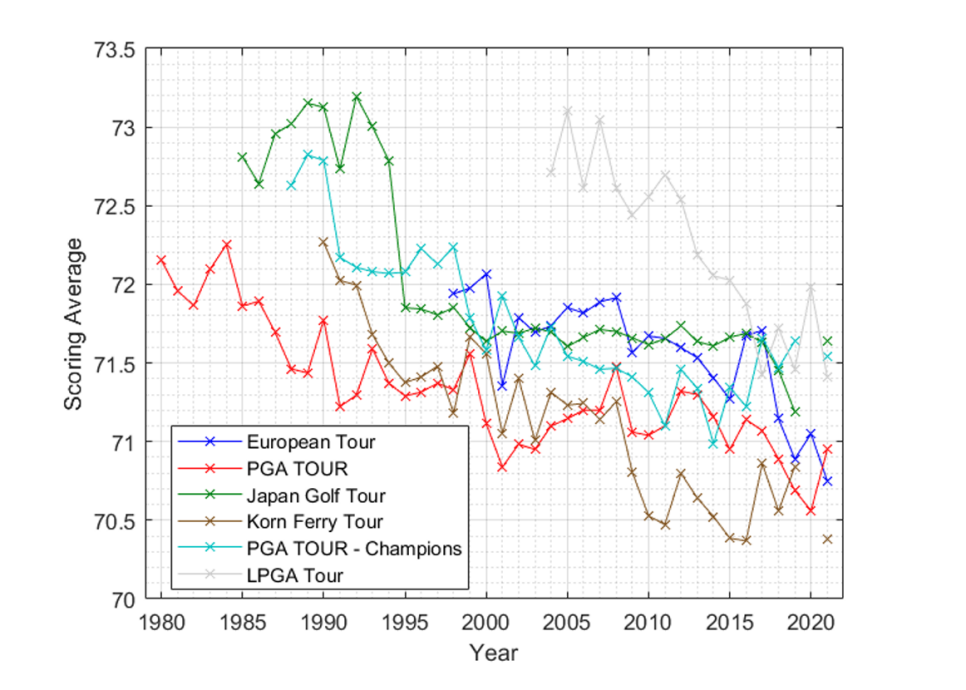
The ruling bodies' announcement on Wednesday of new “areas of interest” included the idea of raising the test swing speed of the golf ball’s Overall Distance Standard to “at least” 125 mph in order to more closely reflect tour player swing speeds. Data from the PGA Tour may indicate that 125 is about as rare as when the ruling bodies chose to update the test to a speed of 120 mph in 2004. This year, the average of the fastest swing speed each player on tour has recorded is about 119 mph.
Thomas Pagel, the USGA’s chief governance officer, said the Overall Distance Standard has adapted to the landscape of the elite men’s game as it has developed.
“We reflected on the intent of that rule to replicate the longest-hitting golfers at the time,” he said. “We just stepped back and observed what we’re seeing at the highest level today with the longest hitters, and recognized that 120 is no longer the number that replicates that. It was really, frankly, a reflection on history, and saying, ‘Are we at another moment in time where we need to go back in and revise this?’
“As for whether 125 is enough, we may find that 125 is not enough, or we may find that 125 is a good number. But 10 years from now, we need to plan on researching and looking at further change so that we can evolve and ensure that the rule continues to model or mirror what we’re seeing the longest hitters in the game doing.”
While the trend in driving distance is clearly upward historically, the rate of increase doesn’t seem out of whack with past numbers. The PGA Tour players may be hitting it 3.6 percent farther in 2021 than in 2003, but when compared to any other similar stretch of time, that rate is nowhere near the highest. In fact, it was the lowest ever recorded in any 18-year span and has been trending downward since 2012.
Then again, there is a fundamental difference between looking at the rate of growth in distance compared to the actual growth. In the last five years, distance on the PGA Tour is increasing at a rate of about a yard per year. That’s less than half what it was in the late 1990s and early 2000s, but more than double the rate from 1980-95. And when those increases are coming on top of a driving distance average that is in the mid-290s now compared to the low 260s then, that’s what has the ruling bodies concerned. It’s not the size of the distance gains, it’s that, at least to the ruling bodies, they don’t appear to be leveling off, despite all the equipment regulations. That’s especially concerning to them at a time almost two decades removed from their Joint Statement of Principles that declared “any further significant increases in hitting distances at the highest level are undesirable.”
The R&A’s Steve Otto, executive director-chief of technology, thinks any ideas about change aren’t simply a reaction to thwart new club and ball developments.
“It’s a recognition that the longest players on which we base the testing speed are getting faster, a recognition of the athletes improving,” he said. “I think that’s why we spent so long on the Distance Insights project. Because if you look year on year, it doesn’t seem to be an issue, but it’s taking that really long-term view.
“This is about where the future of the game is going to be 10 years out, 20 years out, 50 years out.”
The problem may be as simple, or as complicated, as this: Of the 30 longest hitters currently on the PGA Tour, only two (Luke List and Scottie Scheffler) have recorded victories this year and more rank outside the top 100 in FedEx Cup points than inside the top 30. But not one player in the top 30 in FedEx Cup points is hitting it shorter than the tour’s current average driving distance. That number, 296.7, would set an all-time high.
More from Golf Digest
Trending now.
Average Golf Club Distances: Amateurs vs PGA Players

The number one key to breaking 100 and golfing better is knowing the average golf club distances you can hit each of your clubs. In this guide, I’ll give a breakdown of average club distances for men and women, amateurs and PGA tour players.
I’ll also touch on other topics like:
- How does swing speed effect golf club distances ?
- How much does the golf ball impact distance?
- How can you increase your distances for each golf club today?
Let’s start by going over the average golf club distances for each club first.
Pitching Wedge
Gap/approach wedge, average male golf club distances, average female golfer club distances, pga & lpga tour club distances, go to the driving range, use a golf gps app, use a launch monitor at home, practice makes perfect, swing speed, club head speed, smash factor, club sweet spot, wind and weather conditions, consistency, improve your swing technique, strengthen your golf muscles, upgrade your equipment, practice, practice, practice, video guides, conclusion/summary, average golf club distances by club type.
The average driving distance for an amateur is 220 yards off the tee . If you can hit further than that regularly and keep your ball in the fairway more often then not, congratulations!
A detailed breakdown on driver distance by golfer type and gender is as follows:
- Average Male: 235 yards
- Average Female: 180 yards
- PGA Golfer: 298 yards
- LPGA Golfer: 247 yards
- Average Range for Men: 200-270 yards
- Average Range for Women: 150-210 yards
The wide average range for both men and women is due to a number of factors, such as:
- Driver Swing Speed
- Driver Technology
- Golf Ball Speed
- Smash Factor / Quality of Strike
- Experience Level
I’ll break all of that down below. But first, I’ll show you the average distances for all of the other golf clubs in your bag.

The 3 wood is the second-longest club in your bag. It can be used off of the tee, fairway, or a propped up lie in the rough. Because of that, the overall average distance you can hit your 3-wood may range.
Golf’s averages are:
- Average Male: 215 yards
- Average Female: 155 yards
- Average PGA Golfer: 278 yards
- Average LPGA Golfer: 230 yards
- Average Range for Men: 180-240 yards
- Average Range for Women: 125-185 yards
The 5 wood has more loft compared to the 3 wood, which makes it easier to hit up into the air but lowers the distance you can get. Average distances for a 5 wood are:
- Average Male: 200 yards
- Average Female: 140 yards
- Average PGA Golfer: 255 yards
- Average LPGA Golfer: 205 yards
- Average Range for Men: 160-225 yards
- Average Range for Women: 110-175 yards
A lot of golf club sets include a 3 hybrid club instead of a 3 iron because it is much easier to hit. The club head on a hybrid is similar to a wood, promoting longer distance and less spin.
Average distances for a 3 hybrid are:
- Average Maler: 190 yards
- Average Female: 130 yards
- Average PGA Golfer: 235 yards
- Average LPGA Golfer: 195 yards
- Average Range for Men: 160-220 yards
- Average Range for Women: 100-170 yards
A 3 iron is used in similar situations as a hybrid, but you will not be able to hit it as far. Instead, you will see a slightly lower ball speed and more spin. A golf ball hit by a 3 iron will not roll as far after it lands.
Average distances for a 3 iron are:
- Average Male: 185 yards
- Average Female: 125 yards
- Average PGA Golfer: 230 yards
- Average LPGA Golfer: 190 yards
- Average Range for Men: 150-210 yards
- Average Range for Women: 100-160 yards
A 4 iron, like a 3 iron, can be tricky to hit because of its low loft and longer shaft length. However, it’s a key medium-to-long distance iron to hit your approach shots with. It’s a common club to use if you need to punch out of the trees or keep your ball flight low and it has a loft of 24 degrees.
The average golf distances for a 4 iron are:
- Average Male: 175 yards
- Average PGA Golfer: 225 yards
- Average LPGA Golfer: 185 yards
- Average Range for Men: 150-200 yards
- Average Range for Women: 90-160 yards
A 5 iron is a very good club that can be hit by pros and beginners alike. It’s often the lowest lofted iron in a beginner set of club.
The average distances for a 5 irons are:
- Average Male: 165 yards
- Average Female: 115 yards
- Average PGA Golfer: 215 yards
- Average LPGA Golfer: 175 yards
- Average Range for Men: 140-180 yards
- Average Range for Women: 80-140 yards
A 6 iron is when ball spin and stopping power become more important than distance. It has a loft of 31 degrees.
The average distances for a 6 iron are:
- Average Male: 155 yards
- Average Female: 105 yards
- Average PGA Golfer: 205 yards
- Average LPGA Golfer: 165 yards
- Average Range for Men: 130-170 yards
- Average Range for Women: 70-130 yards
For most people, a 7 iron is the club where you add enough spin to the golf ball to erase your natural slice or fade. It has a loft of 34 degrees and it’s average distances are:
- Average Male: 145 yards
- Average Female: 95 yards
- Average PGA Golfer: 195 yards
- Average LPGA Golfer: 155 yards
- Average Range for Men: 120-160 yards
- Average Range for Women: 60-120 yards
An 8 iron has about 37 degrees of loft. It is mostly used as a medium-to-short approach club that allows you to get the ball close to the green.
Average distances for an 8 iron are:
- Average Male: 135 yards
- Average Female: 85 yards
- Average PGA Golfer: 185 yards
- Average LPGA Golfer: 145 yards
- Average Range for Men: 110-150 yards
- Average Range for Women: 55-110 yards
A 9 iron is a versatile club that you can use from further away to stick the ball close to the green. It is also a popular chipping club for “bump-and-run” style shots around the green. The 9 iron has a standard loft of 42 degrees.
The average distance for a 9 iron is:
- Average Male: 120 yards
- Average Female: 70 yards
- Average PGA Golfer: 170 yards
- Average LPGA Golfer: 130 yards
- Average Range for Men: 100-140 yards
- Average Range for Women: 50-100 yards
A pitching wedge is used mainly to hit pitches and chip shots around the green. For amateur golfers, the pitching wedge is the highest lofted club that can be hit reliably from all distances. The rest of the wedges in this guide as used as more niche shots at certain distances only.
The average distances for a full swing pitching wedge are:
- Average Male: 110 yards
- Average Female: 65 yards
- Average PGA Golfer: 155 yards
- Average LPGA Golfer: 115 yards
- Average Range for Men: 80-130 yards
- Average Range for Women: 50-85 yards
A gap or approach wedge has more loft than a pitching wedge and is used for high shots with low bounce. The name comes because it is a “gap” club between the pitching wedge and the sand wedge.
The average distances for a full swing gap wedge are:
- Average Male: 90 yards
- Average Female: 55 yards
- Average PGA Golfer: 135 yards
- Average LPGA Golfer: 105 yards
- Average Range for Men: 70-115 yards
- Average Range for Women: 40-80 yards
A sand wedge is used to help you get out of any bunkers you find yourself in. It has about 56 degrees of loft, which is quite a bit. A lot of beginner golfers cannot hit a good sand wedge because the amount of error is so low.
The average distances of a full swing sand wedge is:
- Average Male: 80 yards
- Average Female: 50 yards
- Average PGA Golfer: 125 yards
- Average LPGA Golfer: 100 yards
- Average Range for Men: 60-110 yards
- Average Range for Women: 40-75 yards
A lob wedge is the highest lofted club in a golf bag at 60 degrees. This lob wedge is used to get a huge amount of height but low distance. When hit properly, a lob wedge will produce lots of backspin.
- Average Male: 70 yards
- Average Female: 40 yards
- Average PGA Golfer: 105 yards
- Average LPGA Golfer: 80 yards
- Average Range for Men: 50-90 yards
- Average Range for Women: 35-60 yards
Average Golf Distance Charts
If you want a quick reference guide, the chart below shows how far the average golfer hits the ball for each club.
Using this chart, you can see how your distance for each club matches up against the average golfer.
How Do You Know Your Average Golf Club Distances?
Knowing how far you can hit each golf club is key to both breaking 100 and becoming a scratch golfer. Without knowing how far you hit each club, you are more likely to sail a ball over the green or leave it short for your next shot.
Here are some tips for figuring out your average golf club distances:
Driving ranges are the perfect spot to work on your swing and make everything more consistent. Ranges will have markers for major distance, allowing you to hit dozens of balls and really determine accurate distances for each club.
You don’t hit some irons in your bag that regularly, so the range is the perfect spot to figure out iron distances.
A golf GPS allows you to see the distance to every green and hazard on the golf course while you are playing your round. The good ones also have AutoShot detection, which track your distances on every shot. You can review your stats after the round is done and review average club distances too.
Click here to read about the Garmin Approach watches , which have AutoShot built into them. You can also read about the best golf GPS watches here.

A golf launch monitor tracks metrics about your swing, including:
- Overall distance
- Attack angle
It is the number one way to understand how you hit each golf club while at home. Pick up a launch monitor, such as the affordable FlightScope Mevo , and a golf hitting net , and you will be able to create your own golf club distance charts.

The ultimate way to know your average club distances is to practice. New golfers don’t hit consistent enough to truly understand how far they can hit each club. Working on your skill level first will allow you to get more accurate results.
PGA tour players know their distances because they practice day in and day out.
Click here to check out golf practice tools.
Factors That Impact Golf Club Distance
There are a lot of different components to your swing that affect the average distance you can hit each of your clubs.
Your average swing speed will have a huge impact on how far the ball travels off of your club head. A slower swing speed won’t be able to hit as far as a faster one. The average PGA player can swing about 115 miles per hours, while the average for a casual golfer is only 90 miles per hour. This is a big reason for the difference in average distance at different skill levels.
How fast your club head is travelling at impact with the golf ball determines how far the ball travels. This is correlated to swing speed, but can also be affected by other factors such as:
- Club technology
- Angle of impact
- Wind conditions
Just like swing speed, average golfers have a tough time generating distance with a slow club head speed.
Smash Factor is the ratio between the speed of the ball when it is hit verses your swing speed. If you make direct contact with the golf ball (club head is exactly perpendicular to the ball), you will have a high smash factor and this has a huge impact on distance. If you your club is not direct to the ball, you will introduce side spin to it and you will hook or slice the ball.
It doesn’t matter how fast or hard you are swinging your club if you are not making contact with the club’s sweet spot. A normal iron will have a sweet spot on the bottom-center of the club, which is the ideal spot to make contact. Golf drivers have a bit higher sweet spot because you hit the ball off of a tee.
Making contact with the sweet spot will generate faster ball speed and that satisfying “pop” sound when you make contact.
Distance can be greatly impacted by the conditions on the course. Hitting into the wind will shorten the distance you can get. A side wind will add spin to your golf ball and steer it off path. You will increase your distance if you have a strong wind behind you. A humid day will shorten your shots because of the added air density.
Because of this, the average golf club distances you get are only a guideline. You need to take into account the conditions of the day in order to know the true distance for each shot.
Above everything else, consistency is key. You won’t be able to reliably know your exact distance unless you know that your swing is identical every time.
How Can You Increase Your Golf Club Distance?
If you want to hit the golf ball further, there are a number of things you can do.
Improving your swing technique is perhaps the most effective way to increase your golf club distance. Try these things to practice a more powerful and efficient swing:
- Maintain proper posture : Stand tall with your knees slightly bent and your weight evenly distributed between your feet.
- Grip the club correctly : Hold the club with a firm but relaxed grip, allowing your wrists to hinge during the swing.
- Rotate your body : Focus on rotating your hips, torso, and shoulders in sync, which will generate power and speed in your swing.
- Stay balanced: Keep your weight centered and avoid swaying during the swing.
Click here to read more tips on how to play golf better.
Increasing your strength, particularly in the muscles used during a golf swing, can have a significant impact on your club distance. Incorporate these exercises into your fitness routine:
- Core exercises : Planks, Russian twists, and medicine ball rotations.
- Lower body exercises : Squats, lunges, and deadlifts.
- Upper body exercises : Push-ups, pull-ups, and seated rows.
The right equipment can make a noticeable difference in your golf club distance. Consider upgrading to:
- Custom-fit clubs : Clubs tailored to your body measurements and swing can help you make better contact with the ball.
- Low-compression golf balls : These balls can provide more distance, especially for golfers with slower swing speeds.
- High-quality golf shoes : Shoes with proper support and traction can help you maintain balance and generate more power in your swing.
As with any skill, practice is essential to increasing your golf club distance. Spend time at the driving range working on your swing technique, and consider taking lessons from a golf professional to fine-tune your skills.
With dedication and persistence, you’ll start to see improvements in your distance and overall game.
Want to learn more? Here are some helpful videos on golf club distances that you can watch:

Above, I went over the average golf club distances for each gender and golfer type. This is a guideline to help you determine and compare your own results to. In order to pinpoint how far you can hit each wood, iron, and wedge, you need to practice a lot and work on your swing.
Going to the driving range or buying your own launch monitor is the best way to start to understand your own hitting. If you have any other method that has worked well for you in the past, comment down below and let us know today.
Frequently Asked Questions About Golf Ball Distances (FAQs)
What are the average golf club distances for male amateur golfers.
For male amateur golfers, the average golf club distances tend to vary based on the club used. For example, a driver can reach between 200-230 yards, a 3-wood about 180-210 yards, a 5-iron usually covers 140-160 yards, and a 9-iron approximately 100-120 yards. Remember, these distances can significantly fluctuate depending on factors such as technique, physical strength, and weather conditions.
What is the average golf club distance for a PGA professional male golfer?
PGA professional male golfers tend to achieve significantly longer distances due to their advanced skill level and physical conditioning. Typically, a driver for a PGA pro can reach distances of 280-320 yards, a 3-wood about 240-270 yards, a 5-iron roughly 200-220 yards, and a 9-iron around 150-170 yards. Keep in mind, though, that these distances can vary based on the individual player’s style and environmental factors.
Does golf club type impact the average hitting distance?
Yes, the type of golf club has a substantial impact on the average hitting distance. Each club is designed with a specific purpose and trajectory in mind. Longer clubs like drivers and woods are designed to hit the ball further, while shorter clubs like irons and wedges provide more control and are used for shorter distances. The loft, or angle of the clubface, also plays a crucial role in determining the distance a ball can travel.
How can I increase my average golf club distances?
Improving your average golf club distances requires a blend of factors including improved swing mechanics, increased physical fitness, and often, upgraded equipment. Golf technology is continually evolving, so using up-to-date clubs can also give you an edge.
Does weather affect golf club distances?
Yes, weather plays a significant role in golf club distances. In warmer conditions, the ball can travel further as the air is less dense. Wind direction can also drastically affect your shot distance and trajectory. Understanding these variables and adjusting your game accordingly is a crucial aspect of golf strategy.
Ryan William
With over 25 years hands-on experience in the golfing world, Ryan is not just an avid golfer but a topical authority. His journey has had him delve deep into the nuances of the sport, from mastering the swing to understanding new golf technology. As an entrepreneur, Ryan is at the forefront of the latest golf trends, reviewing all new clubs, accessories, and training aids. His insights and expertise are backed by a prolific writing career, with over 1000 articles published across various platforms. Ryan's commitment is clear: to guide and inform the golf community with unparalleled knowledge and passion.
Last update on 2024-04-27 / Affiliate links / Images from Amazon Product Advertising API
Leave a Comment Cancel reply
Save my name, email, and website in this browser for the next time I comment.
Modern Golf Apparel

Save on TaylorMade, Callaway & more!
PGA TOUR Player Stats 2024
- Statistics are updated nightly
- AGE : Current age of player
- EARNINGS : Official money won
- CUP : FedExCup Points
- EVNTS : Tournaments played
- RNDS : Rounds played
- CUTS : Cuts made
- TOP10 : Top 10 finishes
- WINS : Wins
- SCORE : Scoring average per round
- DDIS : Driving distance (in yards)
- DACC : Driving accuracy %
- GIR : Greens In Regulation %
- PUTTS : Putts per hole
- SAND : Save Percentage
- BIRDS : Birdies per round
- Terms of Use
- Privacy Policy
- Your US State Privacy Rights
- Children's Online Privacy Policy
- Interest-Based Ads
- About Nielsen Measurement
- Do Not Sell or Share My Personal Information
- Disney Ad Sales Site
- Work for ESPN
- Corrections
Power Rankings: Zurich Classic of New Orleans
Power Rankings
Change Text Size
From a two-tournament week to a two-man tournament. That’s the transition to this week’s Zurich Classic of New Orleans.
Numerous golfers from both the Corales Puntacana Championship and the RBC Heritage have reunited to form 80 partnerships at TPC Louisiana south of New Orleans. An explanation of the format, a review of the course, what’s at stake, an early look at the weather and more details are below.
OTHER TEAMS CONSIDERED
- Doug Ghim and Chan Kim
- Luke List and Henrik Norlander
- Davis Thompson and Andrew Novak
- Thomas Detry and Robert MacIntyre
- Parker Coody and Pierceson Coody
Since the first edition of the Zurich Classic as a team competition in 2017, a common curiosity has been how the two-man collaborations are formed. While PGA TOUR membership status plays a role in the field construct to a certain extent, not all teams are as simply understood as the three pairs of brothers who have joined forces this week – Matt and Alex Fitzpatrick, Nicolai and Rasmus Højgaard and TOUR rookies Parker and Pierceson Coody. The last two pairs are twins, too.
Fan interest in the relationships always varies wildly, and that’s always part of the fun, but one of the more fascinating storylines is the connection between 2022-23 PGA TOUR Rookie of the Year Eric Cole and one-time PGA TOUR winner Russ Cochran. The 65-year-old lefty is making his 600th career PGA TOUR start and first in 11 years. Cochran’s son, Reed, is Cole’s caddie, so it’ll be a family affair for the milestone.
Official World Golf Ranking points are not distributed for this tournament but the start does not contribute to divisors, so it’s a free play. Meanwhile, each member of the winning team will receive 400 FedExCup points (i.e., the average between 500 and 300 reserved for first and second place, respectively). He’s also credited with an official PGA TOUR victory that will yield exemptions into next month’s PGA Championship and the 2025 editions of The Sentry and THE PLAYERS Championship. Each also will be exempt as a TOUR member in the winners category through 2026.
To prevail, the winning team will navigate the first and third rounds of better ball and the second and final rounds of alternate shot. The 36-hole cut will be low 33 teams and ties.
TPC Louisiana is unchanged as it concerns distance and turf conditions. It’s a stock par 72 that tips at 7,425 yards. Overseeded Bermudagrass greens can reach 12½ feet on the Stimpmeter, while the only layer of rough is not overseeded and trimmed to 2 inches.
Favorable weather throughout is expected, thus TPC Louisiana should present its best self. Perfect conditions on Thursday should give at least one team a reasonable look at the tournament record of 59 with which Cantlay and Schauffele opened their wire-to-wire victory in 2022. Winds will freshen on Friday and remain moderate in their push from the south for the remainder. Daytime temperatures will climb into the 80s.
The traditional top-10 exemptions into next week’s THE CJ CUP Byron Nelson are reserved for golfers among the top five teams and ties at the Zurich Classic.
NOTE: ShotLink is not utilized for this tournament.
ROB BOLTON’S SCHEDULE
- MONDAY : Power Rankings
- TUESDAY : Sleepers
- WEDNESDAY : Golfbet Insider
- SUNDAY : Points and Payouts; Medical Extensions; Qualifiers; Reshuffle
Rob Bolton is a Golfbet columnist for the PGA TOUR. The Chicagoland native has been playing fantasy golf since 1994, so he was just waiting for the Internet to catch up with him. Follow Rob Bolton on Twitter .

LPGA Tour player average distances: Driver, irons, wedges through the bag
The average LPGA Tour player doesn't hit their driver 300-plus yards. In fact, very few players on the LPGA hit any 300-yard drives. On average, an LPGA Tour player hits their ball longer than most recreational golfers, but their average distances are somewhat closer to how the average younger amateur experiences the game.
How far LPGA Tour players hit the golf ball with each club in their bag isn't an exact science, however. Every player is different, with a different swing, a different angle of attack, different swing speeds and more. Every situation -- off the tee, from the fairway or rough -- is different. So, we wanted to give you an idea of how far is far and how short is short among LPGA Tour players.
We'll take you through the bag to show you LPGA Tour players' average distances with their driver, irons and wedges.
Remember, these are general numbers that don't account for special late-in-tournament situations where a player may be particularly jacked with adrenaline and hit it farther than normal. It's also worth noting that there does appear to be a bigger spread in possible distances off the tee for LPGA Tour players compared to PGA Tour players.
Of course, elevation can affect how far the ball travels as well, though most LPGA events are not played at significant elevation.
LPGA Tour player average distances: Driver, irons, wedges
- Driver: 230-290 yards
- 3-wood: 190-260 yards
- 3-iron: 185-215 yards
- 4-iron: 170-200 yards
- 5-iron: 160-190 yards
- 6-iron: 150-175 yards
- 7-iron: 140-160 yards
- 8-iron: 135-155 yards
- 9-iron: 120-140 yards
- PW: 100-120 yards
- SW: 70-95 yards
About the author
Ryan Ballengee
Ryan Ballengee is founder and editor of Golf News Net. He has been writing and broadcasting about golf for nearly 20 years. Ballengee lives in the Washington, D.C. area with his family. He is currently a +2.6 USGA handicap, and he has covered dozens of major championships and professional golf tournaments. He likes writing about golf and making it more accessible by answering the complex questions fans have about the pro game or who want to understand how to play golf better.
Ryan talks about golf on various social platforms:
X or Twitter: https://twitter.com/ryanballengee Facebook: https://facebook.com/ryanballengeegolf Instagram: https://instagram.com/ryanballengee YouTube: https://youtube.com/@ryanballengeegolf
Ballengee can be reached by email at ryan[at]thegolfnewsnet.com
Ryan occasionally links to merchants of his choosing, and GNN may earn a commission from sales generated by those links. See more in GNN's affiliate disclosure.
- CBSSports.com
- Fanatics Sportsbook
- CBS Sports Home
- Champions League
- Motor Sports
- High School
- Horse Racing
Men's Brackets
Women's Brackets
Fantasy Baseball
Fantasy football, football pick'em, college pick'em, fantasy basketball, fantasy hockey, franchise games, 24/7 sports news network.
- CBS Sports Golazo Network
- PGA Tour on CBS
- UEFA Champions League
- UEFA Europa League
- Italian Serie A
- Watch CBS Sports Network
- TV Shows & Listings
The Early Edge
A Daily SportsLine Betting Podcast
With the First Pick
NFL Draft is coming up!
- Podcasts Home
- The First Cut Golf
- Beyond the Arc
- Eye On College Basketball
- NFL Pick Six
- Cover 3 College Football
- Fantasy Football Today
- My Teams Organize / See All Teams Help Account Settings Log Out
2024 Zurich Classic fantasy golf rankings, picks, strategy: Back Conners and Pendrith, fade McIlroy and Lowry
Sportsline's eric cohen locked in his pga tour fantasy golf rankings, picks and lineups for the zurich classic of new orleans 2024 at tpc louisiana.
Scottie Scheffler has won four of his last five starts -- with a runner-up in the other -- but no one has to worry about him finishing at the top of the leaderboard at the 2024 Zurich Classic of New Orleans. That's because the World No. 1 isn't a part of the field, which consists of 80 pairs of teams, so you'll have to look elsewhere for Zurich Classic fantasy picks. The event begins on Thursday from TPC Louisiana and utilizes alternating formats of best ball and foursomes, with Zurich Classic fantasy lineups consisting of two-man teams instead of individual golfers.
It is the only PGA Tour event that uses the team stroke play format, which saw Nick Hardy and Davis Riley shoot a tournament record 30-under-par in their victory last year. That duo is at +8000 in the latest Zurich Classic 2024 odds, which makes them an intriguing team to maneuver into a fantasy golf strategy. The teams at the top of the odds board are Patrick Cantlay and Xander Schauffele (+500), Rory McIlroy and Shane Lowry (+800) and Will Zalatoris and Sahith Theegala (+1100). Before making any 2024 Zurich Classic fantasy golf picks, you have to see the Zurich Classic fantasy golf rankings from SportsLine handicapper Eric Cohen .
Cohen is an avid golf bettor who correctly predicted the pre-tournament outright winner of the 2024 Masters (Scottie Scheffler, +350), Players Championship (Scheffler +550), 2023 Rocket Mortgage Classic (Rickie Fowler +1400), 2023 PGA Championship (Brooks Koepka +2000), 2023 Honda Classic (Chris Kirk +3500), 2022 Open Championship (Cameron Smith +2200), 2022 U.S. Open (Matt Fitzpatrick +2500), and 2022 Phoenix Open (Scheffler's first career victory at +2800).
Cohen is a contributor to SportsLine's YouTube shows including "Early Edge" and is the host of "The Early Wedge" golf show. Anyone who has followed Cohen's predictions has made positive gains on their golf picks.
Now, Cohen has ranked his top golfers for the 2024 Zurich Classic. Cohen's picks are only available at SportsLine .
2024 Zurich Classic expert picks
We can tell you he is backing the duo of Corey Conners and Taylor Pendrith at +3500. The styles of these two complement each other as well as you'll find with any team as Conners is an elite ball-striker who ranks in the top 15 in strokes gained: tee-to-green, greens in regulation percentage and strokes gained: approach the green. Meanwhile, Pendrith's strengths are his first shot and his final shot. He ranks ninth on tour in driving distance and is 22nd in strokes gained: putting.
The two lowest scores in this tournament's history have come in the last two years, so breaking par repeatedly is essential. This pairing cumulatively ranks in the top 10 of the field in birdies or better gained, with Conners ranking in the top 20 of the entire PGA Tour in both total birdies and total eagles. Add in that Pendrith finished 13th at this tournament last year while playing with a golfer currently ranked 792nd in the world, and the sky's the limit with him now teaming with the No. 51 golfer in World Ranking.
On the other hand, Cohen is fading the oddsmakers' second choice, McIlroy and Lowry at +800. This will be McIlroy's first start at TPC Louisiana while Lowry has played it four times previously. He has just one top 25 over that stretch -- which includes when it was both an individual event and a team event -- and he's missed two of four cuts. This year, Lowry has twice as many finishes outside the top 40 (four) as he has inside the top 10 (two).
That's still twice as many top 10s as McIlroy has in 2024 as the Irishman hasn't found the form he had at the end of last season when he ended it with 10 straight top 10s. McIlroy's scoring average of 70.29 ranks just 87th on tour as his short game is struggling. He ranks outside the top 100 in strokes gained: around-the-green, and as is the case with most Pete Dye-designed courses, TPC Louisiana puts an emphasis on the short game. Lowry can't help out his partner much with that aspect as he also ranks outside the top 100 around the green, so this duo is one to avoid considering their short odds. See all of Cohen's Zurich Classic picks at SportsLine .
How to set 2024 Zurich Classic Fantasy golf lineups
For this week, Cohen is backing several underdogs in his 2024 Zurich Classic fantasy golf picks, including a triple-digit longshot team which could "potentially be a wise play in placement bets" and could help spice up your Fantasy golf lineups. See who it is, and get all of Cohen's fantasy golf picks, at SportsLine .
Who wins Zurich Classic 2024, and who are the top teams to target for your PGA fantasy golf picks? Visit SportsLine now to get Eric Cohen's fantasy golf rankings , all from the fantasy expert who has called seven outright winners since 2022, and find out.
Our Latest Golf Stories
How to watch 2024 Zurich Classic
Patrick mcdonald • 1 min read.
2024 PGA Championship odds, picks, best bets, field
Cbs sports staff • 5 min read.
McIlroy, Lowry hang on to co-lead at Zurich Classic
Kyle porter • 3 min read, rory mcilroy, shane lowry leading after day 1 at zurich, patrick mcdonald • 5 min read.
Frankie Capan III shoots 58 on Korn Ferry Tour
2024 zurich classic odds, picks, computer simulation, share video.
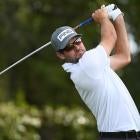
2024 Zurich Classic fantasy golf picks, rankings

Scheffler's run not seen since Woods

Korda nets record 5th straight LPGA win

Report: Woods, McIlroy set to receive loyalty bonuses

Rory McIlroy on expected return to PGA Tour board

2024 PGA Championship odds: Scheffler on top

Scheffler stays hot with fourth win in last five starts
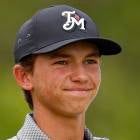
Miles Russell, 15, plays way into next Korn Ferry event
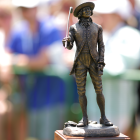
Scheffler earnings up to $16.3 million since March

Davis Love III enthused about golf's young stars

DraftKings PGA DFS Lineup Picks - The Zurich Classic of New Orleans With Rory McIlroy, Shane Lowry, Nick Taylor, Adam Hadwin and More Golf Advice (2024)
Pga dfs rankings wizard - the zurich classic of new orleans.
We have some exciting changes that we are implementing this year over at RotoBaller. There will be multiple subscription-based tiers for our readers to enjoy, including my very own TeeOffSports VIP Package that will include the following items:
PGA Rankings Wizard Model (Pre-Tournament)
- A powerful and interactive data spreadsheet that allows user inputs to create custom rankings and models for golf. If you are considering signing up, take a look at this how-to guide of everything you can find weekly inside my pre-tournament model. The sheet is loaded with sortable and weighable information to help you in all sectors of the market.
- The Zurich Classic of New Orleans
Vegas Report (All Pre-Tournament Bets)
- Top Pre-Tournament H2H Pick: (104-60-9) 63.41%
- All Pre-Tournament H2Hs: (265-194-25) 57.73%
- Total H2Hs Since 2017: (518-361-71) 58.93%
- Outright Winners Since 2017: 42
- Units: + 327.863 Units
- All Totals Are Entering 2024
- Click here to see an example
In-Tournament Model (Updated Stats + User Configuration Ability)
- Here, you will find updated stats for the particular tournament -- all sortable and weighable when you make a copy of your own under the file tab. The purpose of this is to provide an area where you can research the daily proceedings for DFS strategy or find outright or daily head-to-head wagers. There are over 25 weighable categories by the time round four comes around, including the ability to add back in your pre-tournament research for every day.
In-Tournament Head-To-Head Bets For Rounds 1,2,3 and 4
- Lifetime Record: (253-167-46) 60.24%
First-Round Leader Article
- Eight first-round leader wins in 2022.
One & Done (Deep-Dive Into Potential Options To Consider)
- 10+ million in earnings during two of the past three seasons while providing information for contests. We will take a comprehensive look into a handful of options to consider.
Late DraftKings Article (Condensed Player Pool)
- We will build off the Monday article throughout the week and consolidate selections toward a more concrete player pool for everyone to consider by Wednesday.
Premium Discord Access
- Join the community! You will be able to talk to fellow subscribers and have real-time weekly chats with the team.
TeeOffSports membership
- $224.99 per year - Sign up today for all the tools I provide!
- You can also try things out for $14.99 per week or get the complete PGA Platinum package from everyone on the team for $299.99. I believe that deal is one of the best offers in the space since it includes top-notch work from the likes of Joe Nicely , Byron Lindeque, others, and myself!
Field Size: 80 Teams
Cut: Top 33 Teams and Ties
Last Five Winners Of The Zurich Classic of New Orleans
Expected cut-line.
TPC Louisiana
7,425 Yards - Par 72 - Greens Bermuda
It is a tricky week for us at the Zurich Classic, as eighty teams will be competing for the title at TPC Louisiana. The top 33 and ties will get to tee it up all four days, with play getting split between a best-ball format on Thursday and Saturday and an alternate shot structure on Friday and Sunday.
While data isn't as easy to come by as a regular stop because of the lack of trackable data over the last handful of years at this event, I did pre-plug some totals on my DFS Rankings Wizard model to highlight how each tandem would best succeed from an optimal sense. It doesn't mean they necessarily make the right call when the situation arises, but there is a potential advantage to be found when the groups split their alternate shot breakdown correctly.
If you are trying to handicap this from a statistical perspective, over 29 percent of second shots should come from over 200 yards. However, this essentially is a tournament where you get freedom and extra room for aggressiveness during best ball and a lot more strategy from all involved when diving into alternate shot.
Let's Look At The Stats
Let's quickly run through how I built my model.
Weighted Strokes Gained: Total (30%)
Strokes Gained Total: Pete Dye (10%)
Strokes Gained Total: Over 7,400 Yards
Strokes Gained Total: TPC (10%)
Weighted Team Scoring (20%)
Weighted Team Birdie or Better (20%)
Total Number Of Top-10's Out Of The Six Categories: Two-Year Running Model
Total number of top-10's team.
I will dive deeper into what went into these totals later in the week on my podcast. If you aren't doing so already, you can follow Bettor Golf Podcast on X.
First Look Into Outright Bets
Golfers to land in the top 60 of the field for all categories.
Both teammates
Rory McIlroy/Shane Lowry
Sahith Theegala/Will Zalatoris
Individuals
Collin Morikawa
Adam Hadwin
Nicolai Hojgaard
Aldrich Potgieter
Fantasy Golf Lineup Picks for DraftKings (PGA DFS)
We have tons of great weekly PGA articles, DFS analysis, tools and DFS advice . Be sure to read our other fantastic articles regarding this week's event.
High-Priced DraftKings DFS Players
***There are five players priced above $10,000. Please remember that my DFS article is always a first look at the field. Opinions might shift as the week goes on, and I am more than happy to discuss anyone further on Twitter/X.
Pricing will give us the top four teams on the board in the order in which my model projected them this week.
I do think we have to be somewhat cognizant of ownership (good luck finding a pure takeaway from that answer), but I do have concerns that Schauffele/Cantlay will come in massively over-owned compared to the rest of the pack.
For me, this is likely a spot where I want to aggressively back McIlroy/Lowry and Theegala/Zalatoris in builds this week because of their ideal partnership pairings from a data perspective.
There wasn't a team in my model that topped McIlroy/Lowry when comparing their alternate shot format grade since McIlroy on the even holes and Lowry on the odds holes has the chance to provide the best of both worlds. We also get a high-end projection for best-ball formats because of the forceful nature of McIlroy's aggression.
That has the propensity to hurt him in most events, but a triple bogey will easily be excluded from the mix in the best ball stature of the contest if/when Lowry saves the day.
Did you know RotoBaller has a Premium DFS PGA subscription ? Like what you read today? You can show your support for Spencer by using the discount code TEEOFF when purchasing a PGA Premium Pass . You get 10% off and full access to all of our Premium PGA articles, DFS tools, and Lineup Optimizer! You also get access to weekly betting picks from Spencer Aguiar, one of the top betting minds in the industry.
Mid-Priced DraftKings DFS Players
$9,000 Range
I talked a little about my first outright bet in McIlroy/Lowry and will venture into my other play in that sector when diving into Nick Taylor/Adam Hadwin.
Taylor and Hadwin nearly took down the title here last season after shooting 28-under par and closing the weekend with a 64 and 63, respectively.
It is a good spot for the duo here again in 2024 since their top six projected "team grade" in my model got massively bolstered by their relatively high-end scoring marks for each format this week.
Taylor's expected proximity for the course has a chance to play well in alternate shot, and both possess a nice ceiling for birdie-making potential.
$8,000 Range
I had some intrigue on both Chan Kim/Doug Ghim and Davis Thompson/Andrew Novak, but I am going to go with the Thompson/Novak duo here since they possessed slightly more upside if they are able to put the pieces together.
My model ranked both Thompson and Novak in the top 25 for individual expected strokes gained total at this course, and we also got a top-six return for projected scoring at TPC Louisiana to increase that output further when combining their data.
Low-Priced DraftKings DFS Players To Consider ($7,000+)
Check out my model for everything in this section. There, you will get individual rankings on all players and be able to weigh the data to create your very own model when you make a copy. Please consider signing up for this tool that I am very proud to share with the public!
Chris Gotterup and Austin Eckroat graded well as a team because of their past Pete Dye and TPC success as individual players. When you add in the nice mixture of distance versus accuracy for the two thriving in one of those areas, you get a profile that can be very similar to that Riley/Hardy combination that won last season.
$6,000 Options To Consider
The limited data I have for Russ Cochran did present a questionable answer since Cole carried that team a lot with my metrics.
Instead of landing under the expected projection in my sheet that could have some flaws, I am going to go with a ball-striking duo of Smotherman and Meissner to be a surprise top-20 squad in Louisiana. There are some +275 prices out there for them to land in the top 20 that might have a little value to consider.
Favorite Play Each Section:
$10,000+ - Rory McIlroy/Shane Lowry
$9,000+ - Nick Taylor/Adam Hadwin
$8,000+ - Davis Thompson/Andrew Novak
$7,000+ - Chris Gotterup/Austin Eckroat
$6,000+ - Austin Smotherman/Mac Meissner
Win Big With RotoBaller
Our very own Joe Nicely recently took down a big DraftKings DFS tournament for the Travelers Championship. And as an encore, RotoBaller subscriber @tenndolly2 won $100K on FanDuel with the help of Joe and the rest of our Premium PGA team:
Golf DFS News and Player Outlooks
More pga analysis and dfs lineup picks.
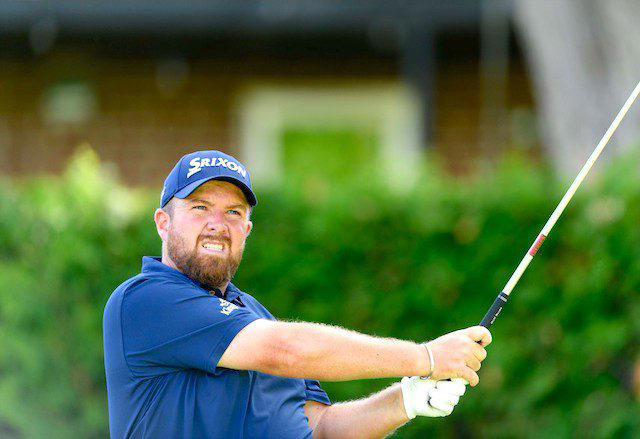

IMAGES
COMMENTS
PGA Tour players hit their driver a 'total' of 296.6 yards on average with a 'carry' distance of 284.3 yards according to official 2022 Shotlink data. The longest player hits it 320 yards on average and the longest recorded drive in 2022 is 460 yards. On the LPGA Tour the top pros hit their driver an average of 257.7 yards.
TrackMan Average Stats Taken From The PGA TOUR . TrackMan LPGA Tour Average Stats . Stats PGA LPGA Tour Averages. Related Posts. Sei Young Kim winner of the Thornberry Creek LPGA Classic. ... I'm about a half club off of PGA Tour average distance wise. Technically I'm a 1 handicap, but more like 4 or 5 when the tourney pressure is on. ...
PGA TOUR AVERAGE CARRY DISTANCES 2021. DRIVER - 275 YARDS. 3 WOOD - 243 YARDS. 5 WOOD - 230 YARDS. HYBRID - 225 YARDS. 3 IRON - 212 YARDS. 4 IRON - 203 YARDS. 5 IRON - 194 YARDS. 6 IRON - 183 YARDS.
2020 PGA Tour Players Average Club Head Speed vs Average Carry Distance, Data Source: pgatour.com. Assuming all other things are equal, more swing speed means more energy that can be transferred from the club to the golf ball, resulting in higher ball speed. Higher ball speed means the ball will travel a further distance.
The average carry distance for a PGA Tour pro with a driver in hand is 275 yards, while the average PGA Tour total driving distance was 299.9 yards in 2023. Their club speed is usually around 113mph with a driver and the resulting ball speed averages 167mph, reaching a max height of just 32 yards off the ground. ...
After all, the further a player drives the ball, the more distance he will lose after the rollback. According to the PGA Tour website, Rory McIlroy, a key figure who supports the change, is at the top of the list for the 2022/23 season with an average driving distance of 326.3 yards. Rory McIlroy supports the golf ball rollback plan.
70 yds. According to the USGA, golf's governing body in the United States, the average male amateur golfer hits driver 217 yards, as recently as 2019. That same year, the PGA Tour average driving distance was 293.9 yards. Men, women, seniors, juniors, professionals, amateurs and beginners all hit their clubs different distances.
Now in 2021, Bryson DeChambeau's average of 320.8 is more than 18 yards longer than Daly's. In fact, the entire PGA Tour's average is almost at the 300 yard mark. This year's 295.3 yard average is ...
When the PGA Tour has an event in Denver, the ball flies closer to 5 percent farther. PGA Tour player average distances: Driver, irons, wedges Driver: 275-350 yards
Average Tour driving distance stayed stagnant from 1990 to 1995, between 260 and 263 yards. Everything was status quo—except for the emergence of John Daly, a player who would be the "driving distance champion" of the PGA Tour for 11 years throughout his career. Daly averaged about 289 yards in 1991, a record at the time.
The PGA Tour average for driver carry distance is an incredible 292 yards. For context, that's around 40 yards longer than a male amateur with an above-average swing speed. 3 Wood: 273 yards. The second longest club for Tour pros is the 3 wood, averaging 273 yards of carry - over 50 yards longer than an above-average amateur!
The PGA Tour accounts for possible variance, such as elevation and wind, and take care to counteract this effect in the chosen holes. The drives are measured at the point in which the ball come to rest regardless of whether it is in the fairway or not. Cameron Champ leads the 2022 Driving Distance category with a whopping average of 326.1 yards.
Zac Blair. 273.8. 13140. 48. 48. Wondering who leads the PGA Tour in drive distance, consecutive cuts, scoring average, or putts per hole? CBS Sports has all of those statistics and more for the ...
PGA TOUR Stats. PGA TOUR, PGA TOUR Champions, and the Swinging Golfer design are registered trademarks.
Since 2003, according to their research, the average driving distance has increased 3.2 percent from 2003-2021. Moreover, the document makes the case that the PGA Tour statistic measuring all ...
Pohl led the tour in driving with a respectable 274.3-yard average and accruing over 51,000 yards driven. Pohl, unfortunately, would not pick up a win on Tour in 1980 — or '81, when he led the ...
World and PGA tours closely tracks the respective tour average driving distances, including the season-to-season fluctuations. When viewed as percentages, there is good consistency ... In 2022, the average clubhead speed on the PGA TOUR was 114.6 mph, with an average launch angle of 10.3° and average spin of 2597 rpm. The mean of the fastest 1 ...
It's a common club to use if you need to punch out of the trees or keep your ball flight low and it has a loft of 24 degrees. The average golf distances for a 4 iron are: Average Male: 175 yards. Average Female: 125 yards. Average PGA Golfer: 225 yards. Average LPGA Golfer: 185 yards.
The average distance on the PGA Tour is a measure of the combined distances achieved by players' shots during a given tournament or season. It is calculated by dividing the total distance covered by all shots by the total number of shots played. This statistic offers valuable insights into the power and proficiency of professional golfers.
The complete 2024 PGA TOUR Driving distance (in yards) rankings on ESPN. The full list of all PGA players ranked based on Driving distance (in yards).
The average driving distance on the PGA Tour refers to the average distance a player's tee shot travels in yards. It is a metric used to measure a golfer's power and ability to hit the ball long off the tee. Typically, the average driving distance is calculated by taking into account the distances recorded on specific holes during tournaments.
The average driving distance on the European Tour and PGA Tour is 294 yards. The average of the longest 20 hitters is 310 yards. DeChambeau leads all PGA golfers with an insane 321 yard average off the tee. Surprisingly, Bryson is only a few yards longer on average than Wyndham Clark (319) and Cameron Champ (318).
ATLANTA, GEORGIA - AUGUST 27: Viktor Hovland of Norway plays his shot from the fifth tee during the final round of the TOUR Championship at East Lake Golf Club on August 27, 2023 in Atlanta, Georgia.
10: Corey Conners and Taylor Pendrith : First-time pairing of the Canadians in this tournament. Conners hasn't appeared in five years while Pendrith checked up at T13 last year.
The par-71 landscape is one of the tightest driving courses on TOUR. So much so, the field driving distance average is 15 yards less than the PGA TOUR average. Accuracy off the tee exceeds the ...
The average LPGA Tour player doesn't hit their driver 300-plus yards. In fact, very few players on the LPGA hit any 300-yard drives. On average, an LPGA Tour player hits their ball longer than ...
SportsLine's Eric Cohen locked in his PGA Tour fantasy golf rankings, picks and lineups for the Zurich Classic of New Orleans 2024 at TPC Louisiana ... He ranks ninth on tour in driving distance ...
TPC Louisiana. 7,425 Yards - Par 72 - Greens Bermuda. It is a tricky week for us at the Zurich Classic, as eighty teams will be competing for the title at TPC Louisiana.